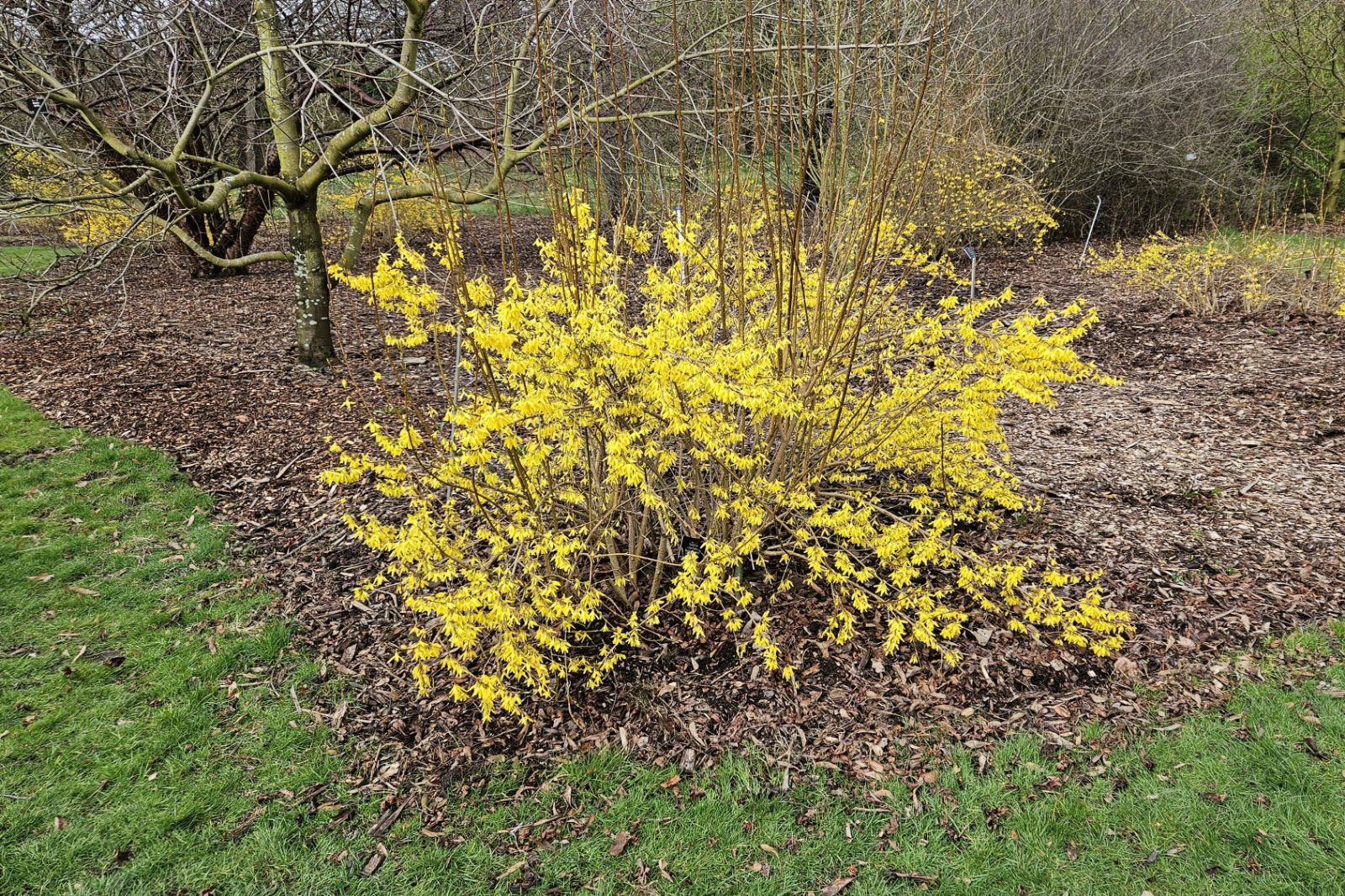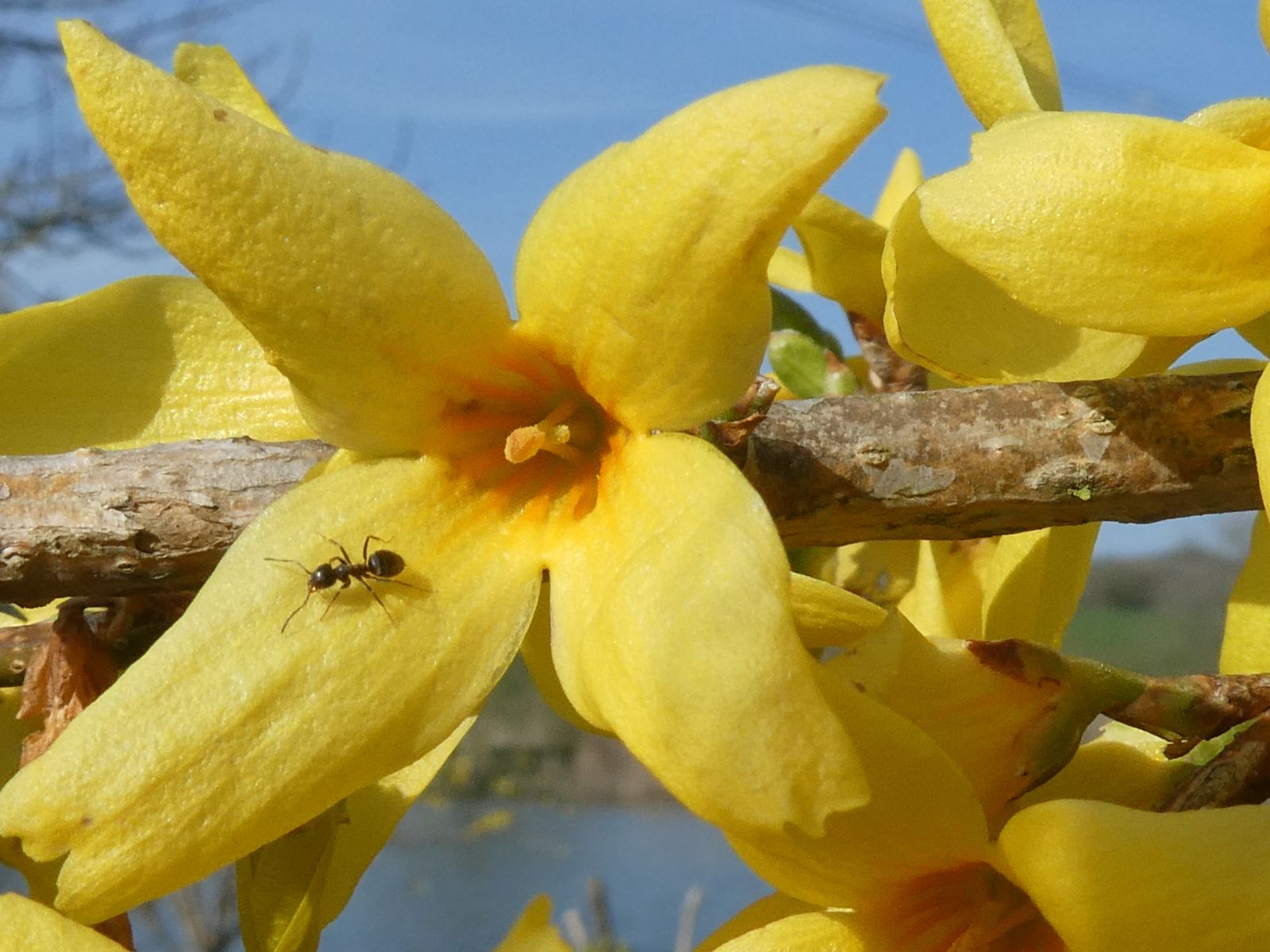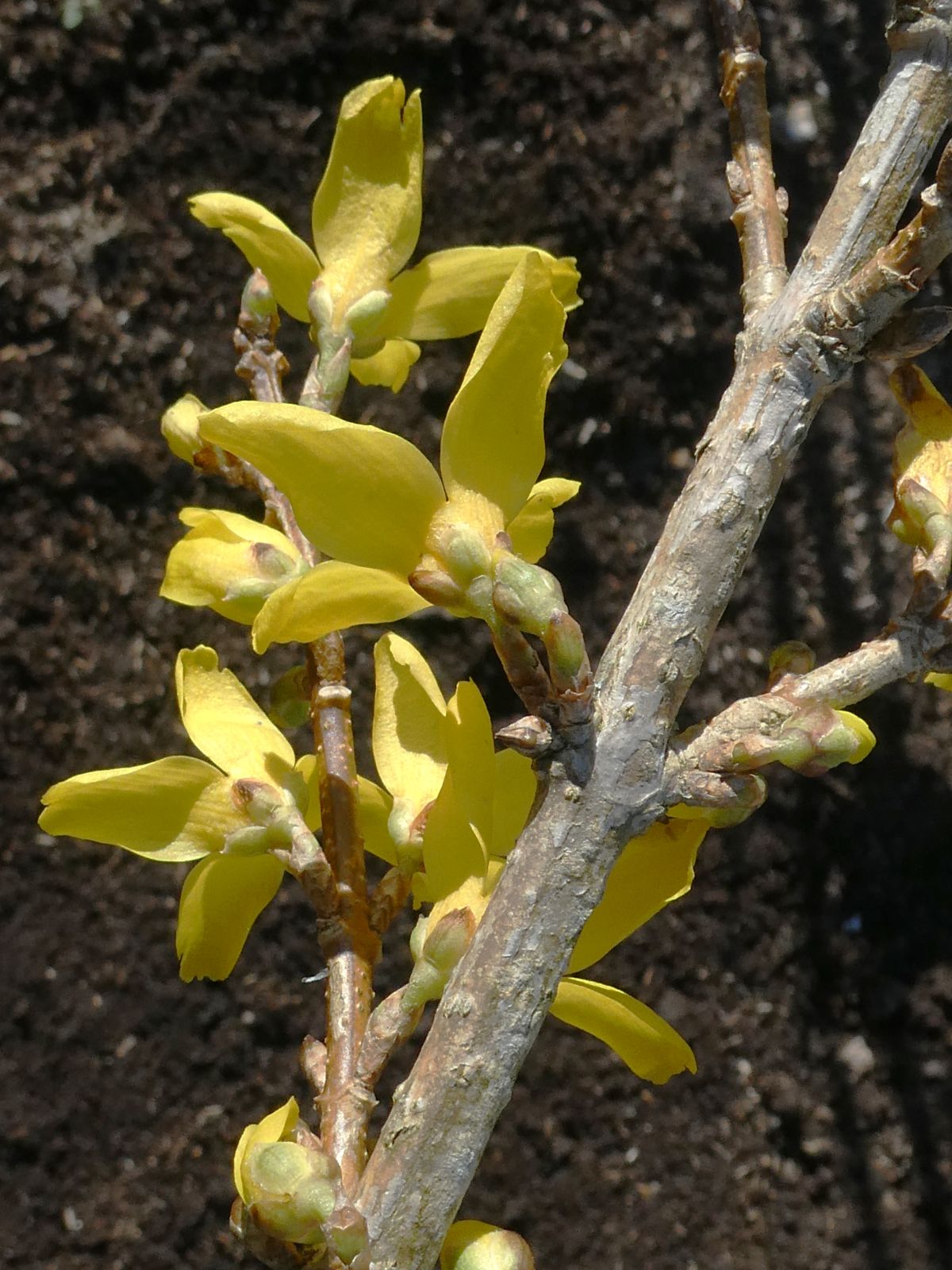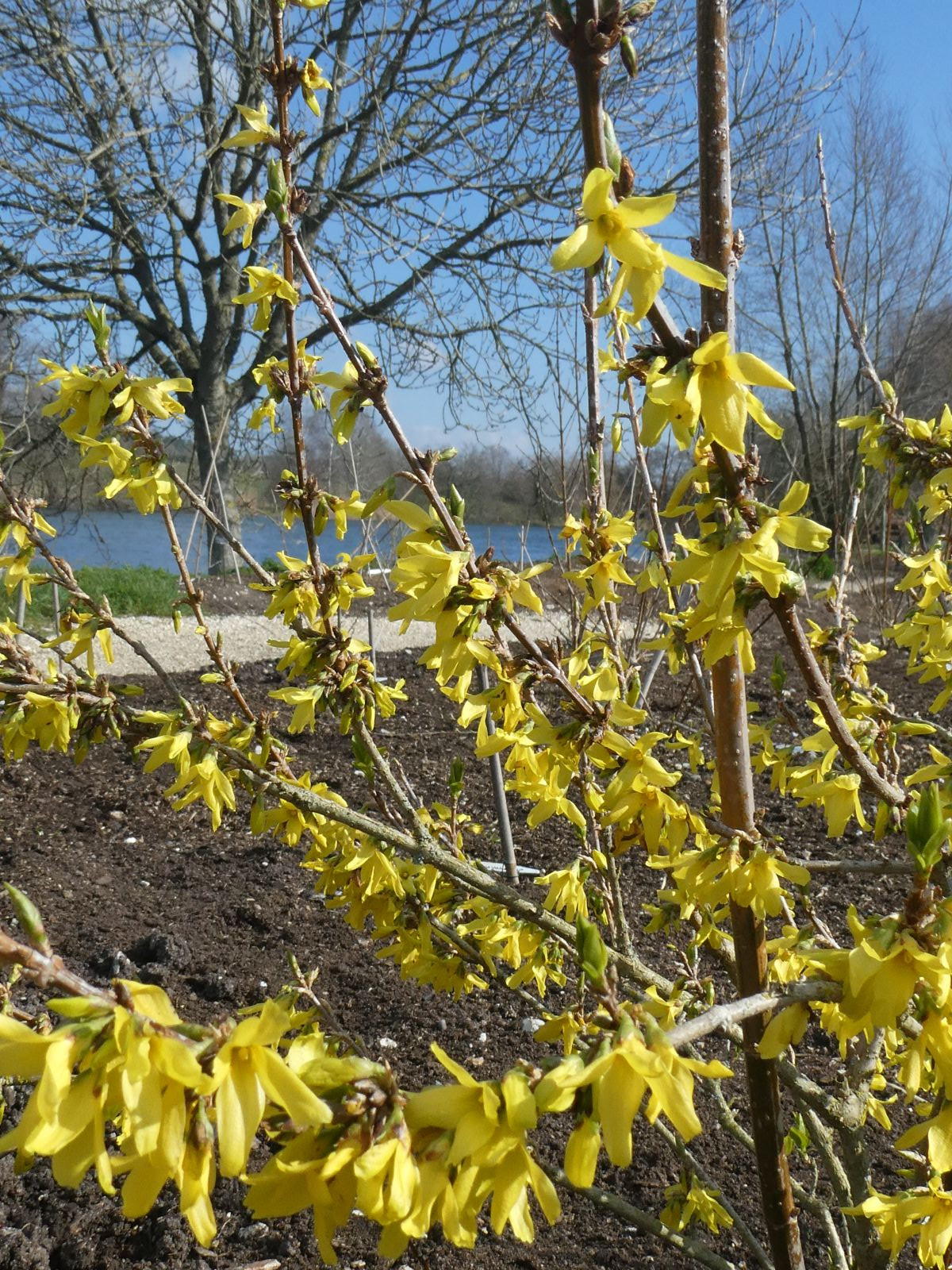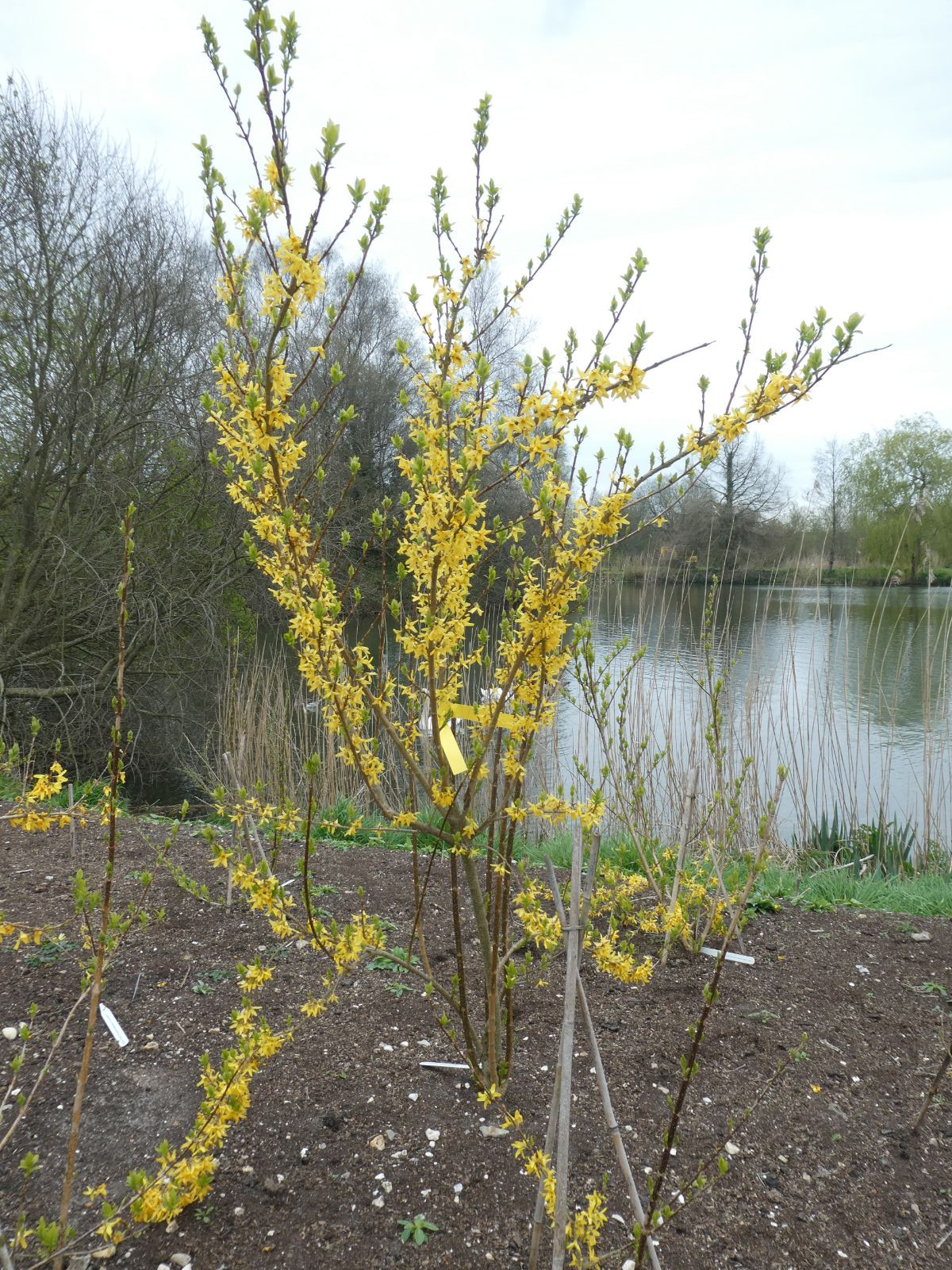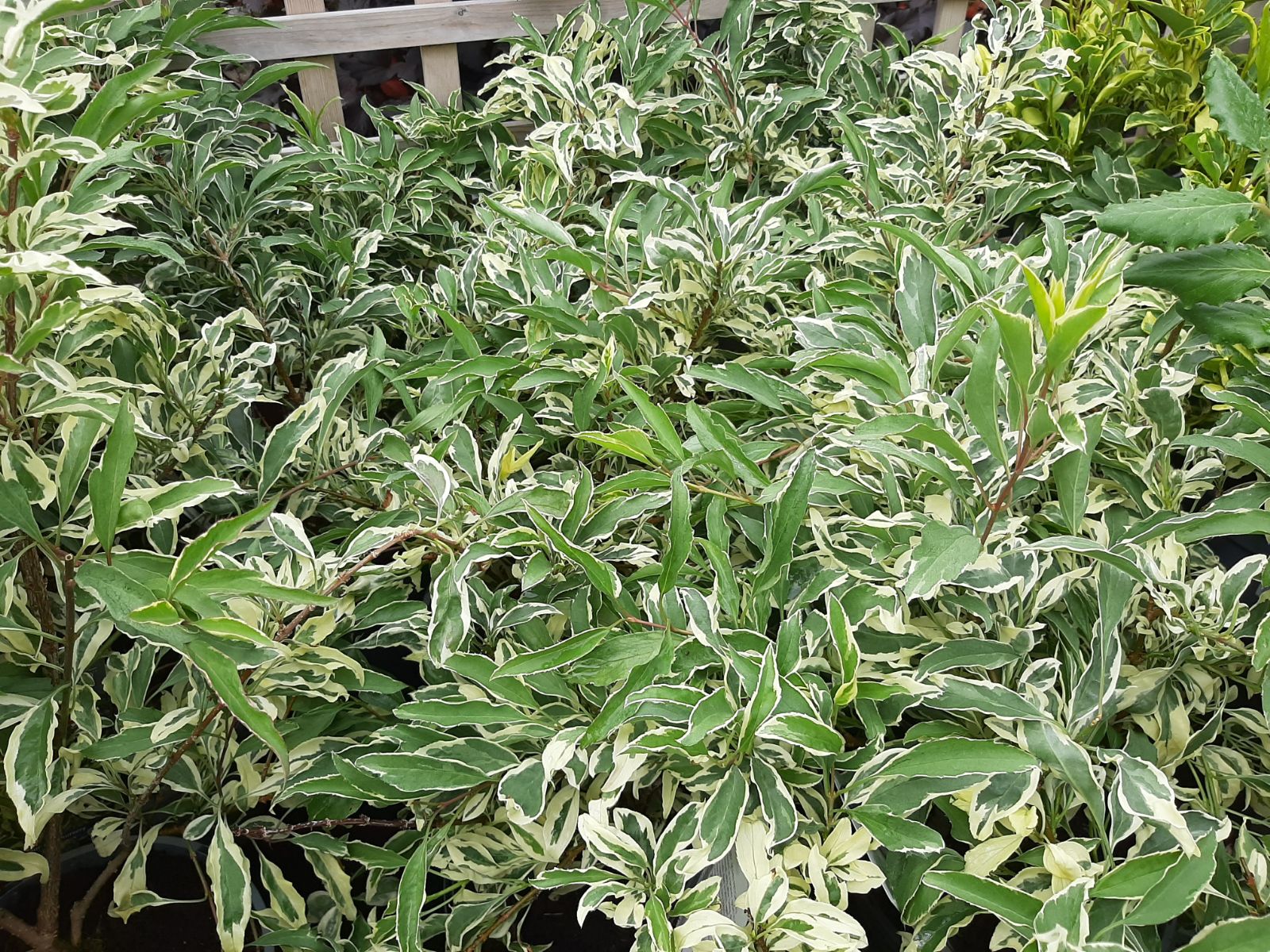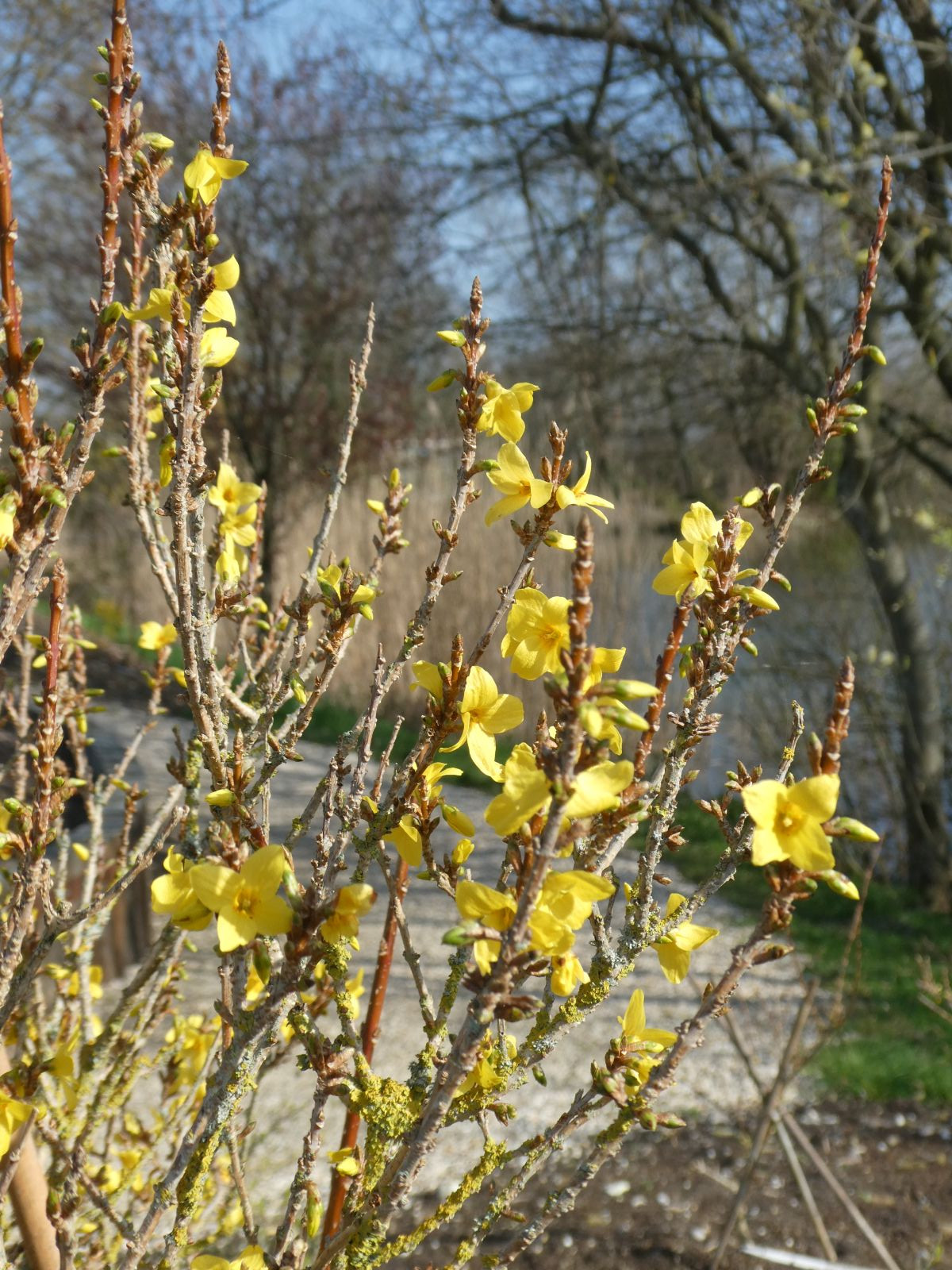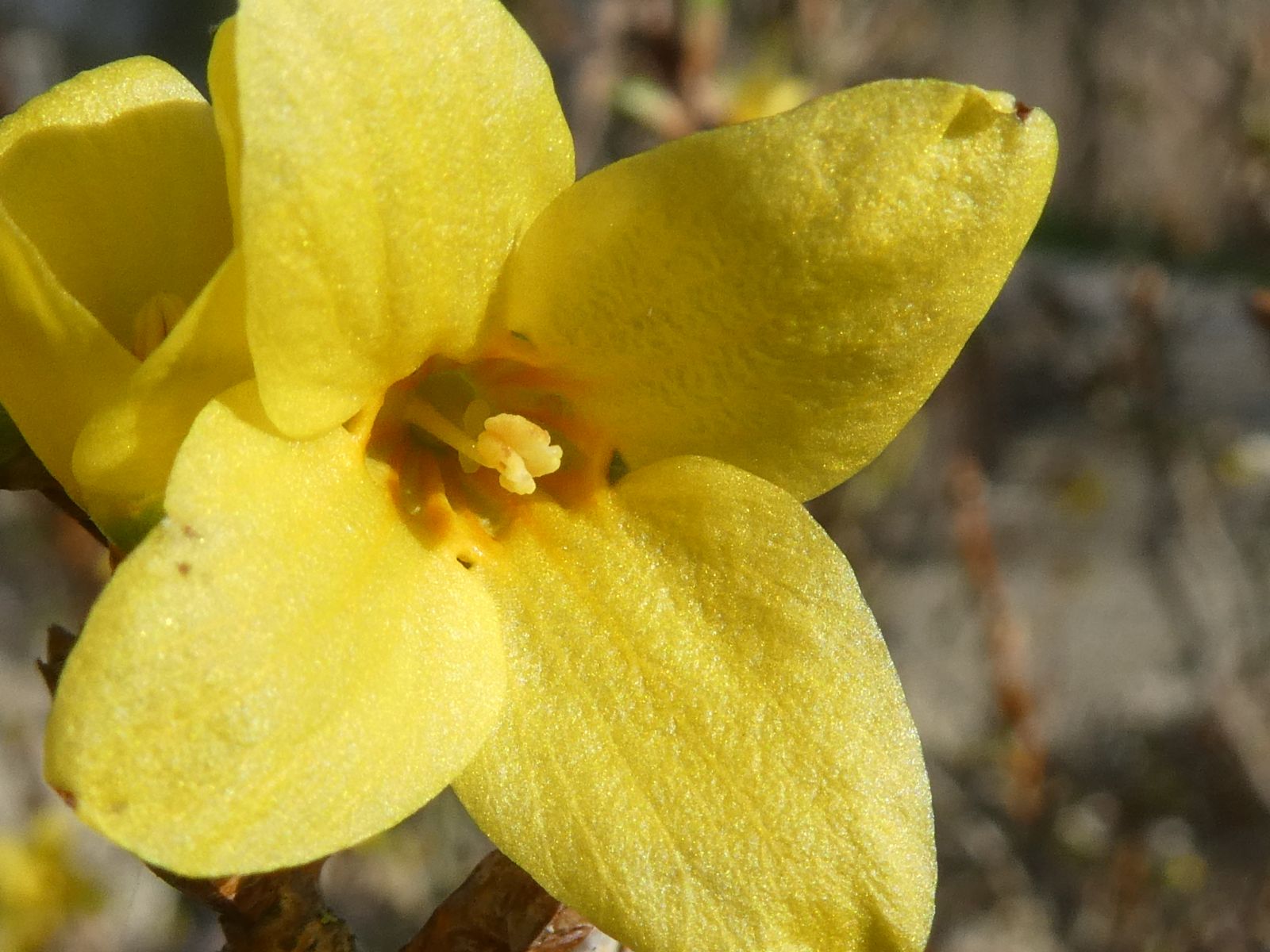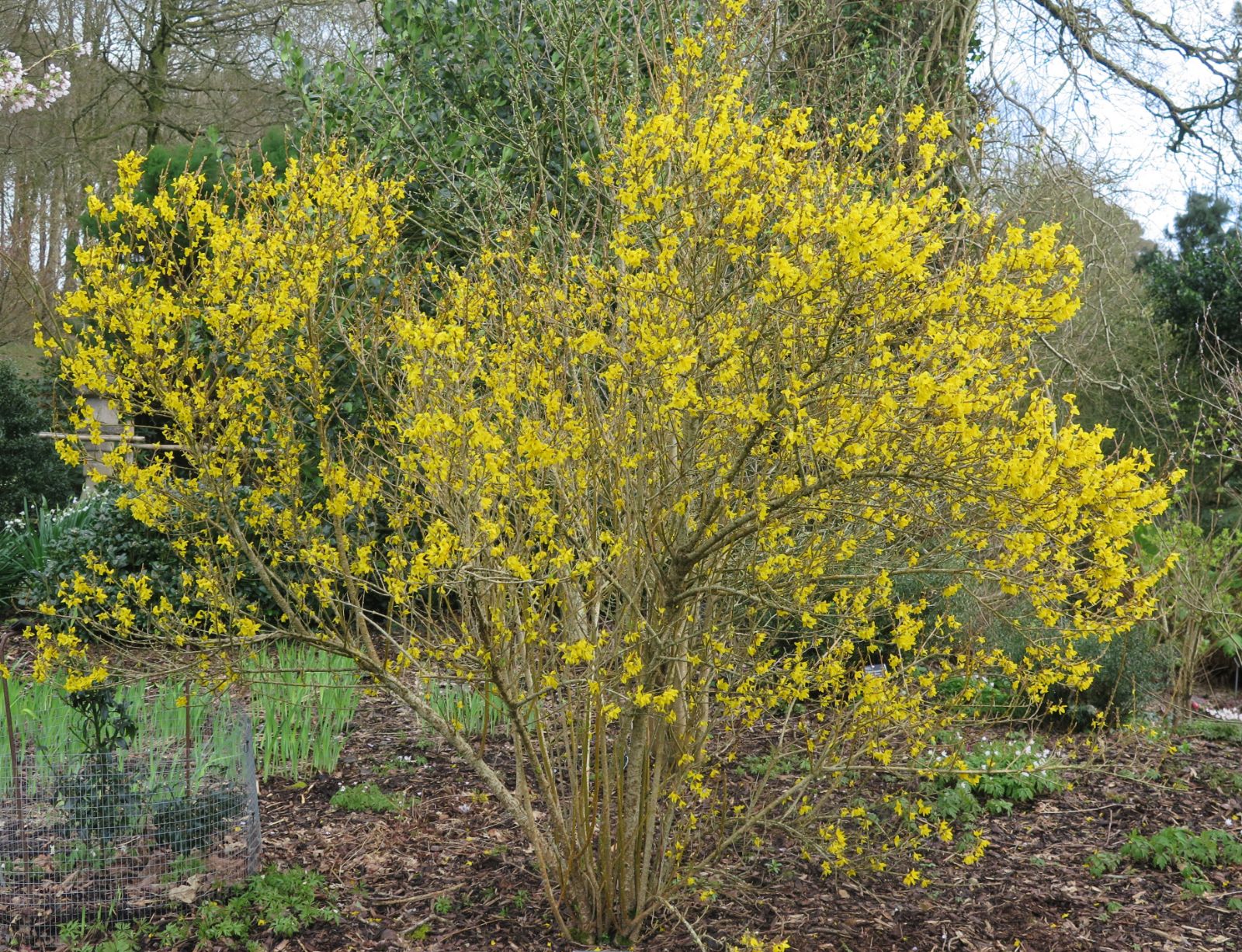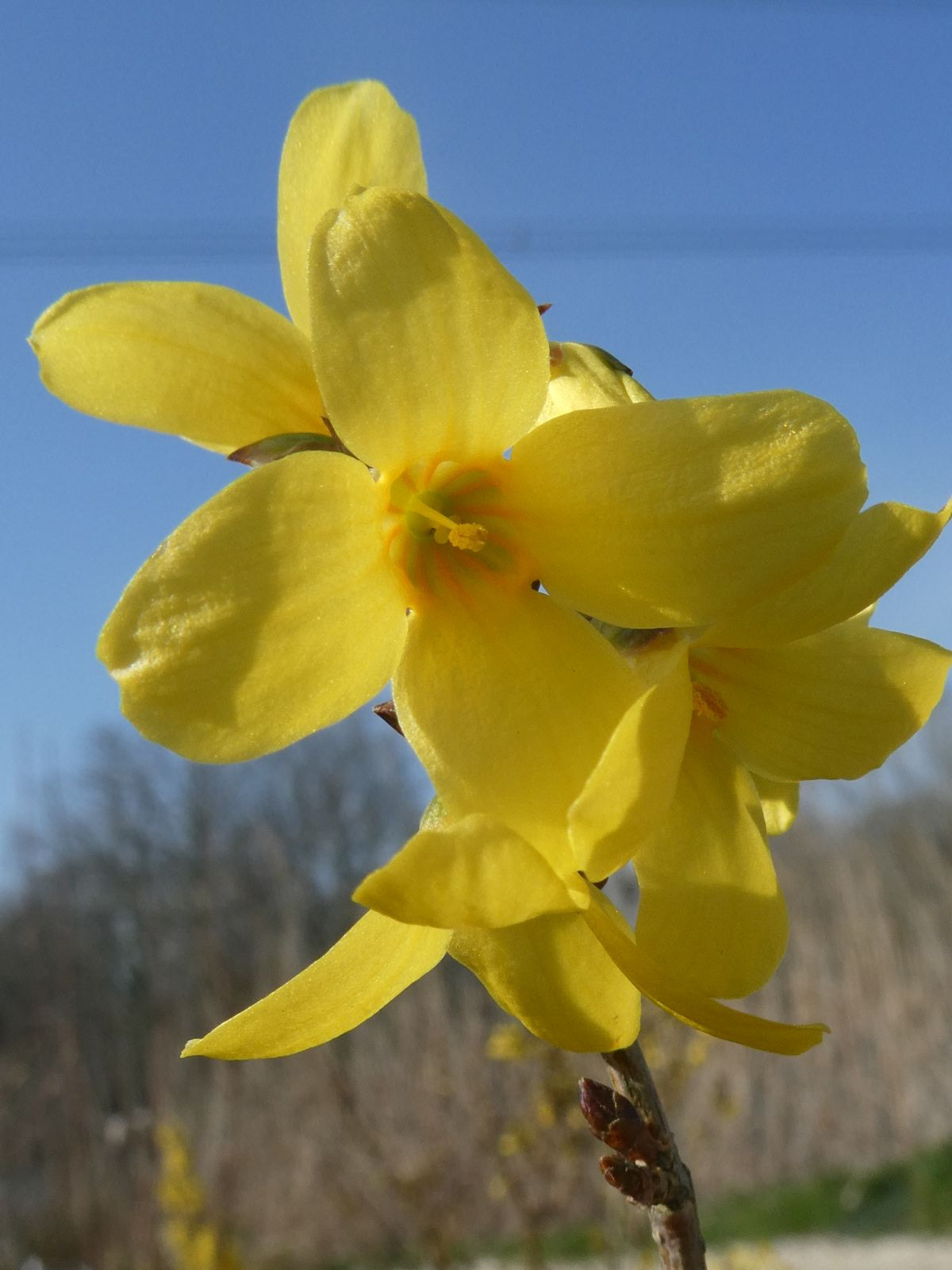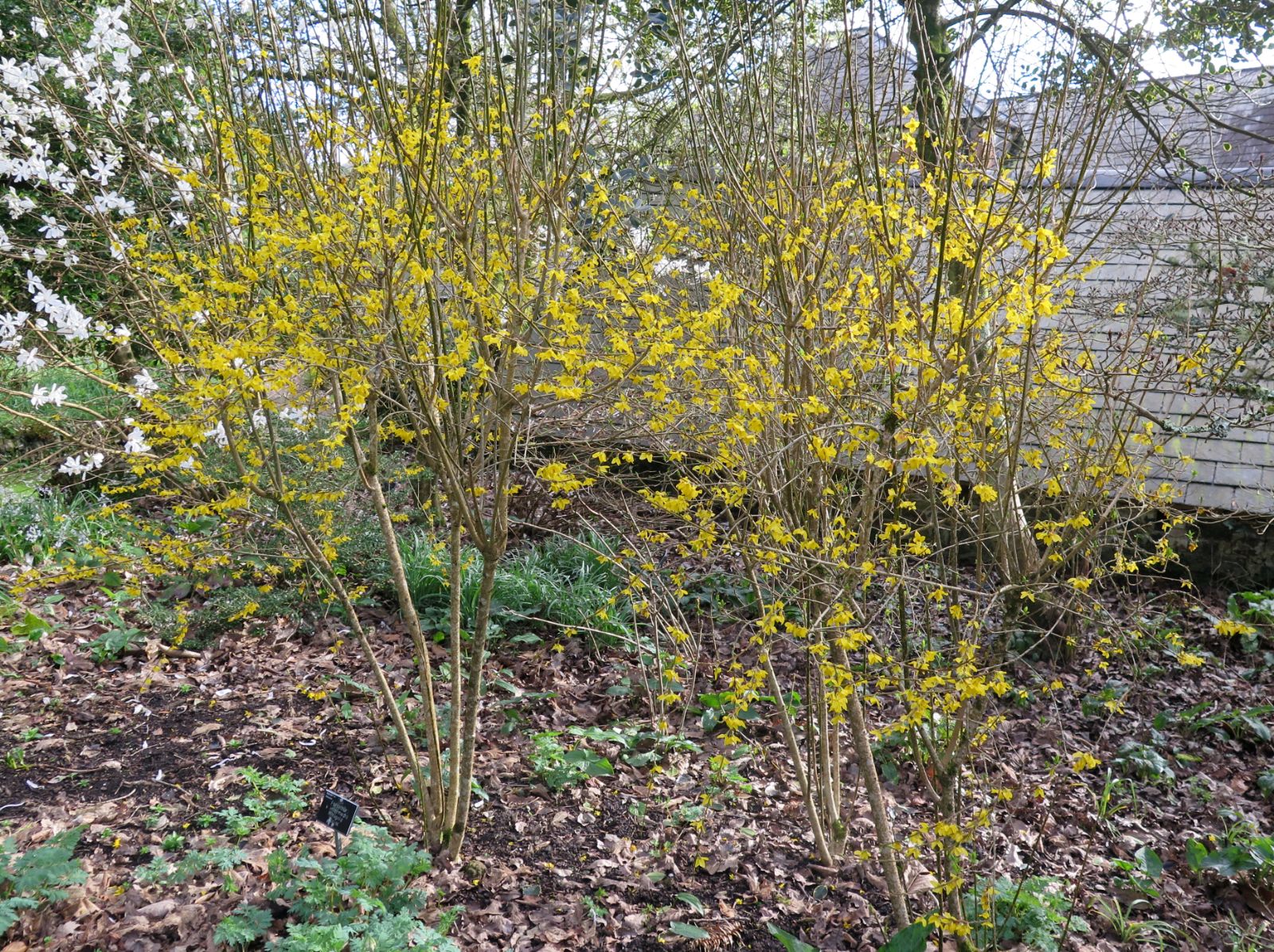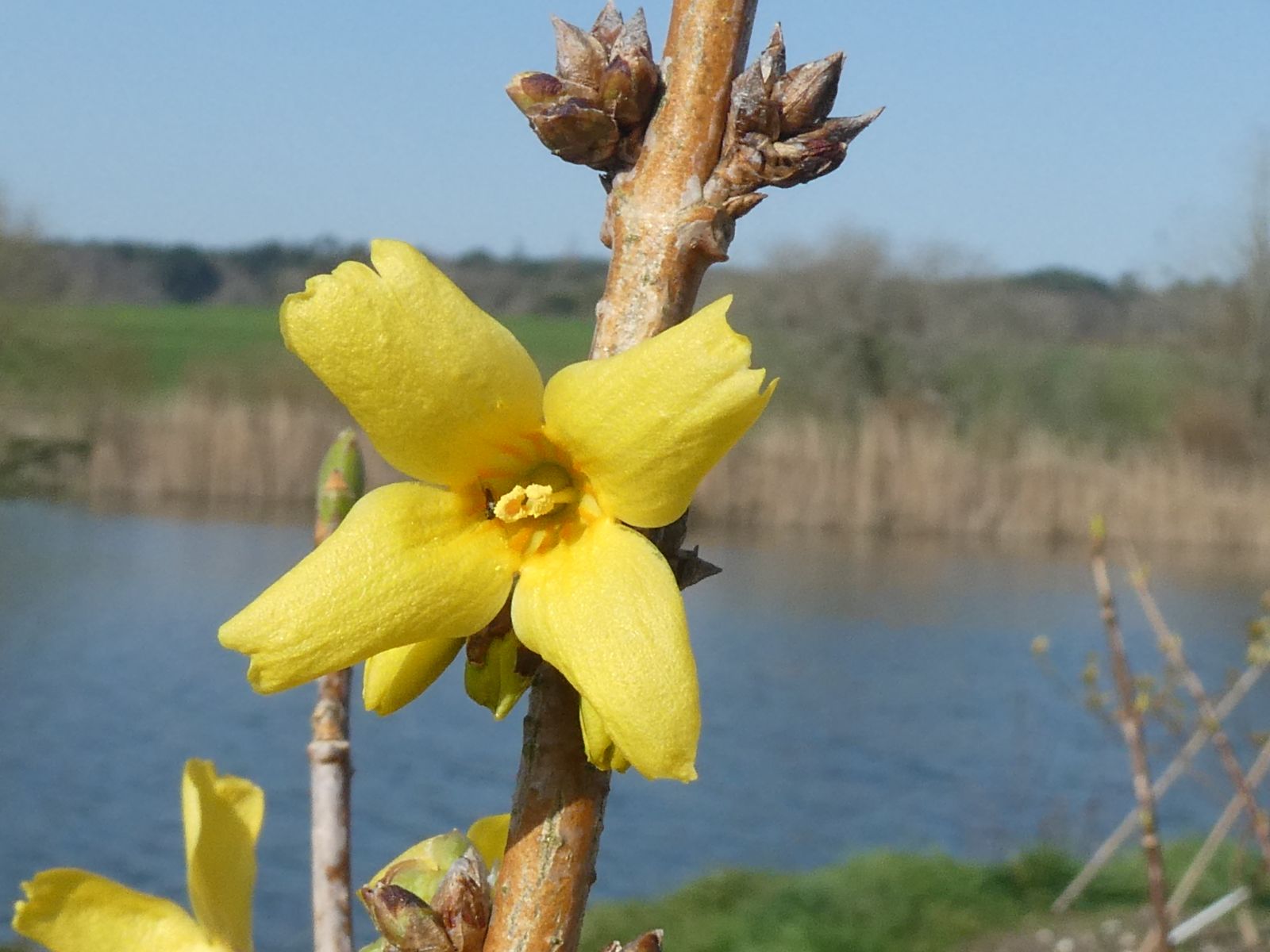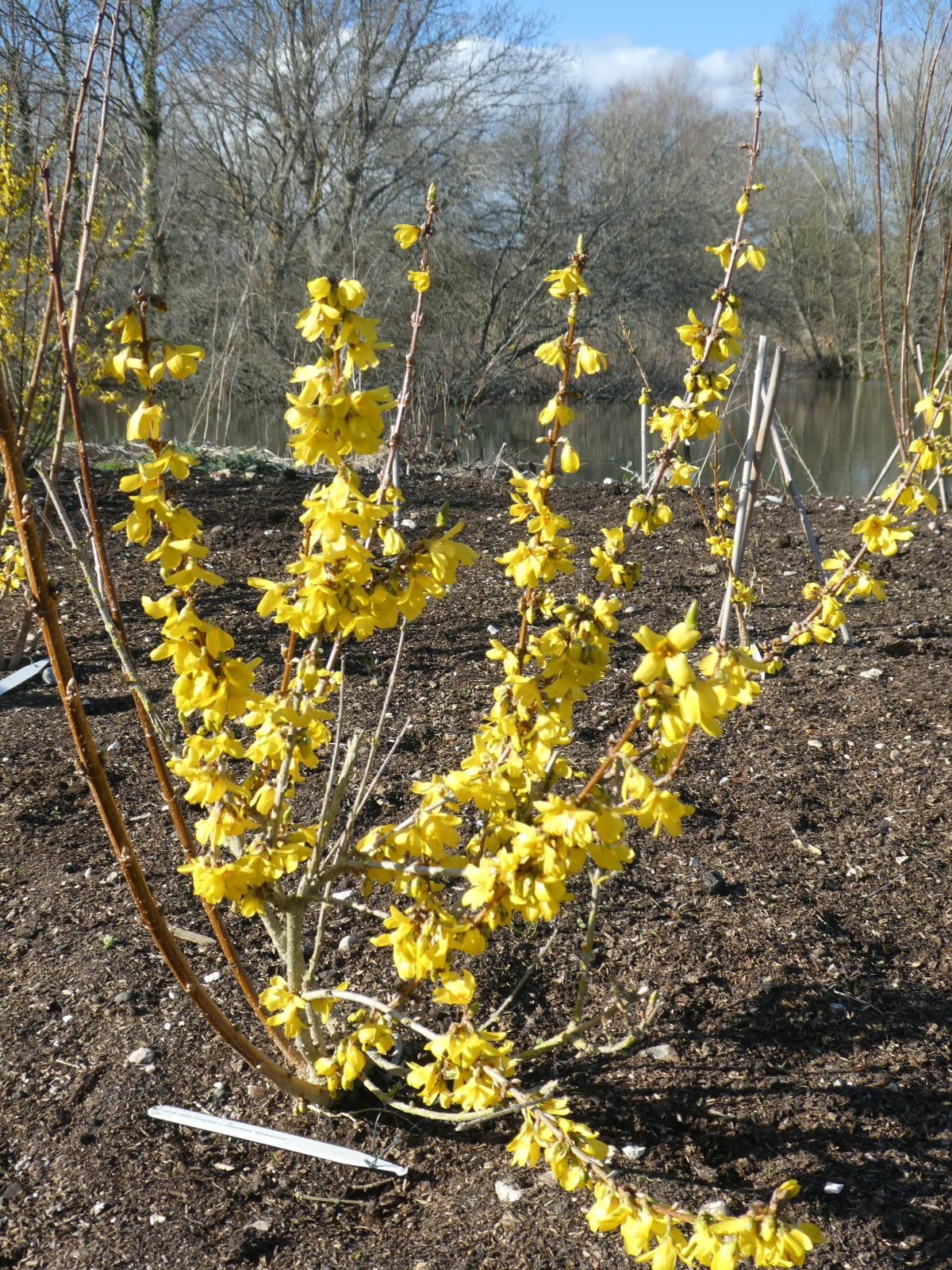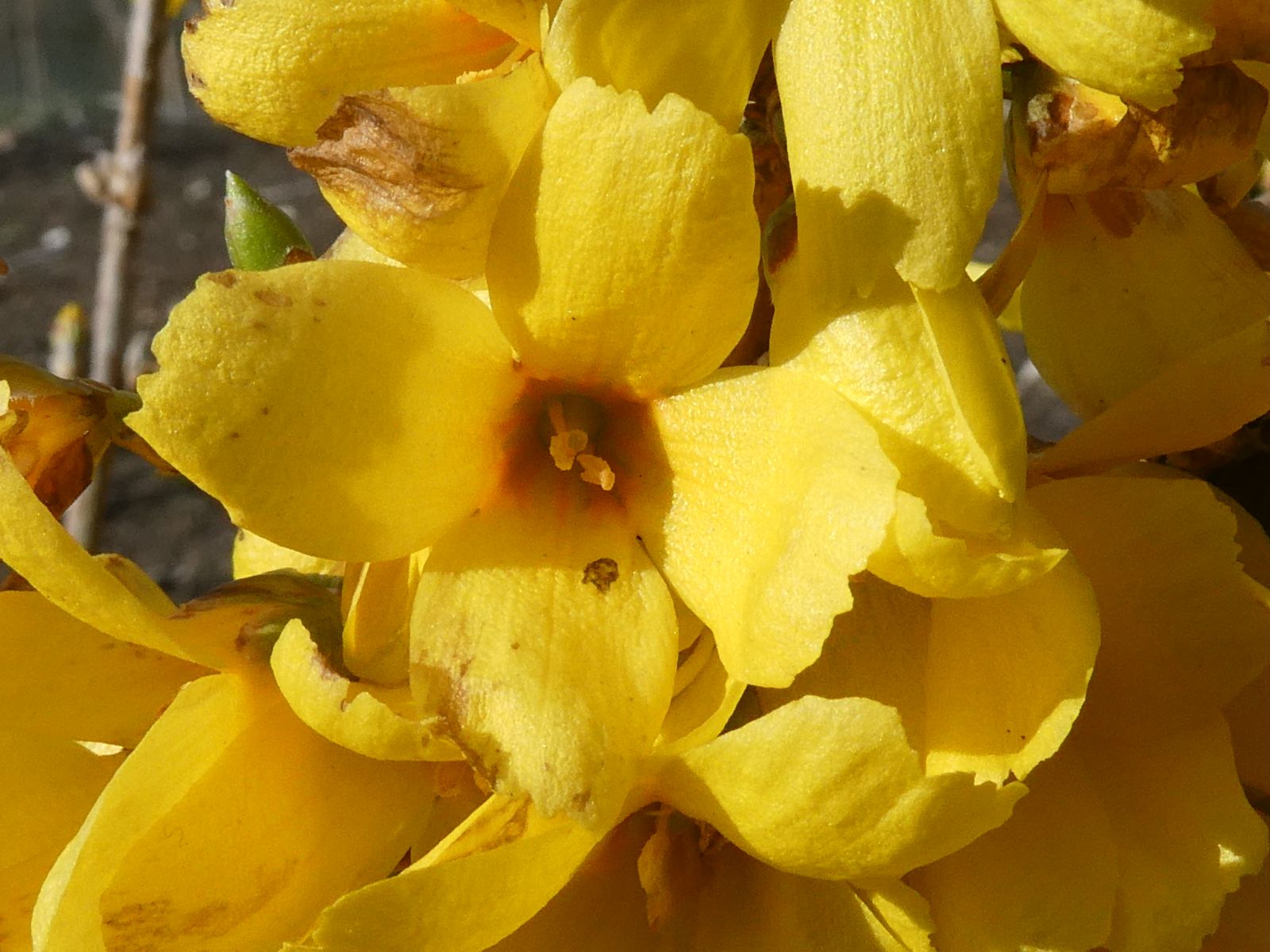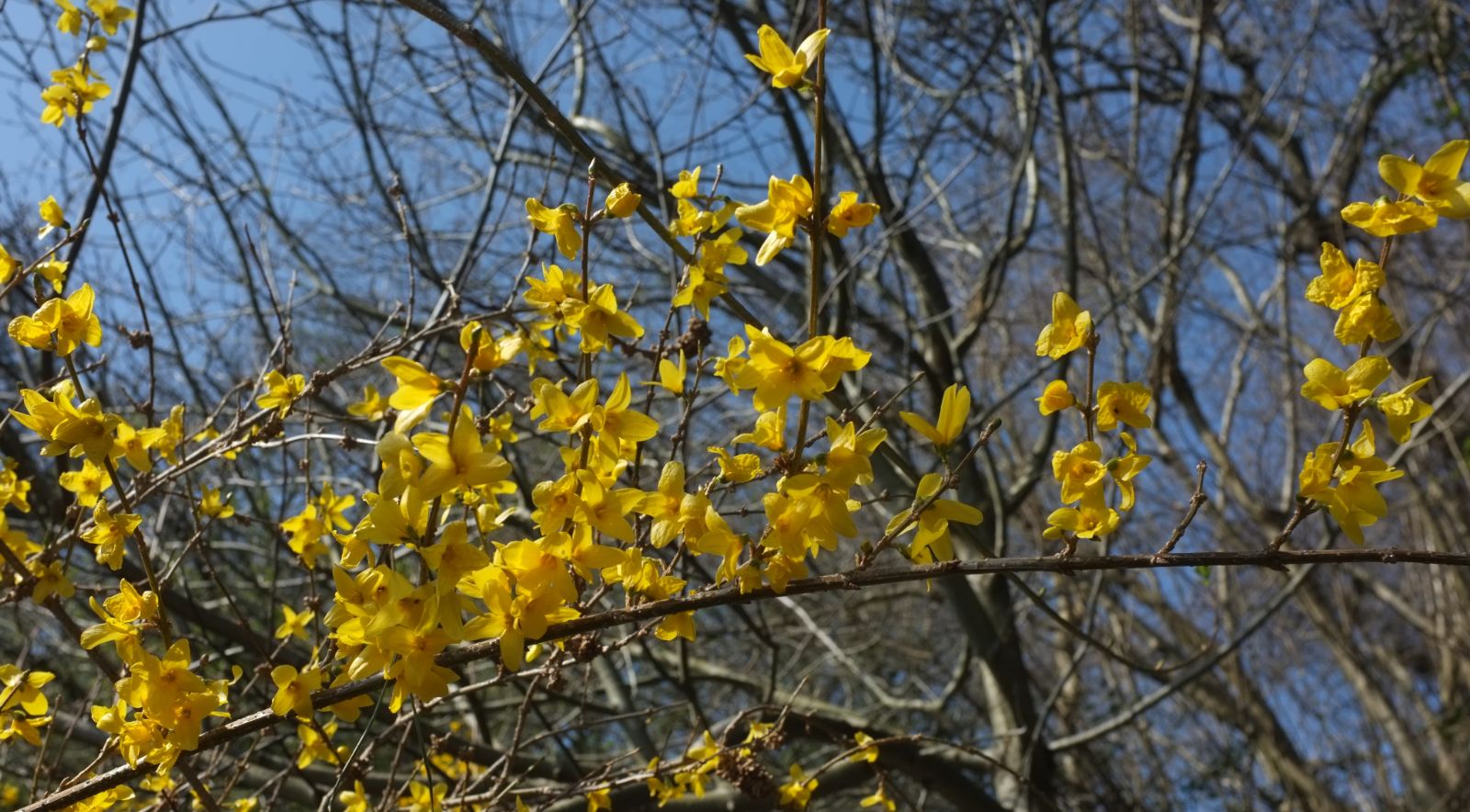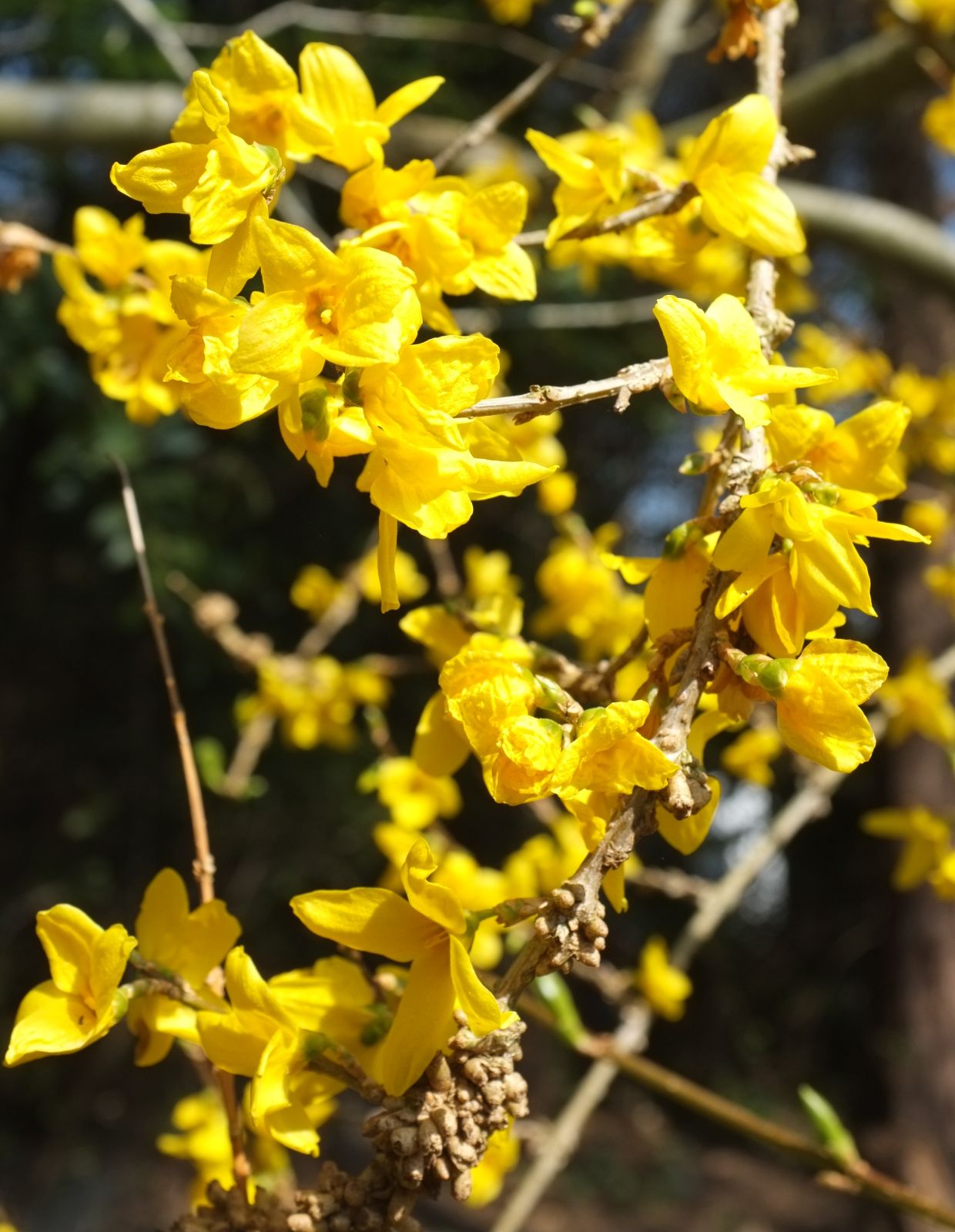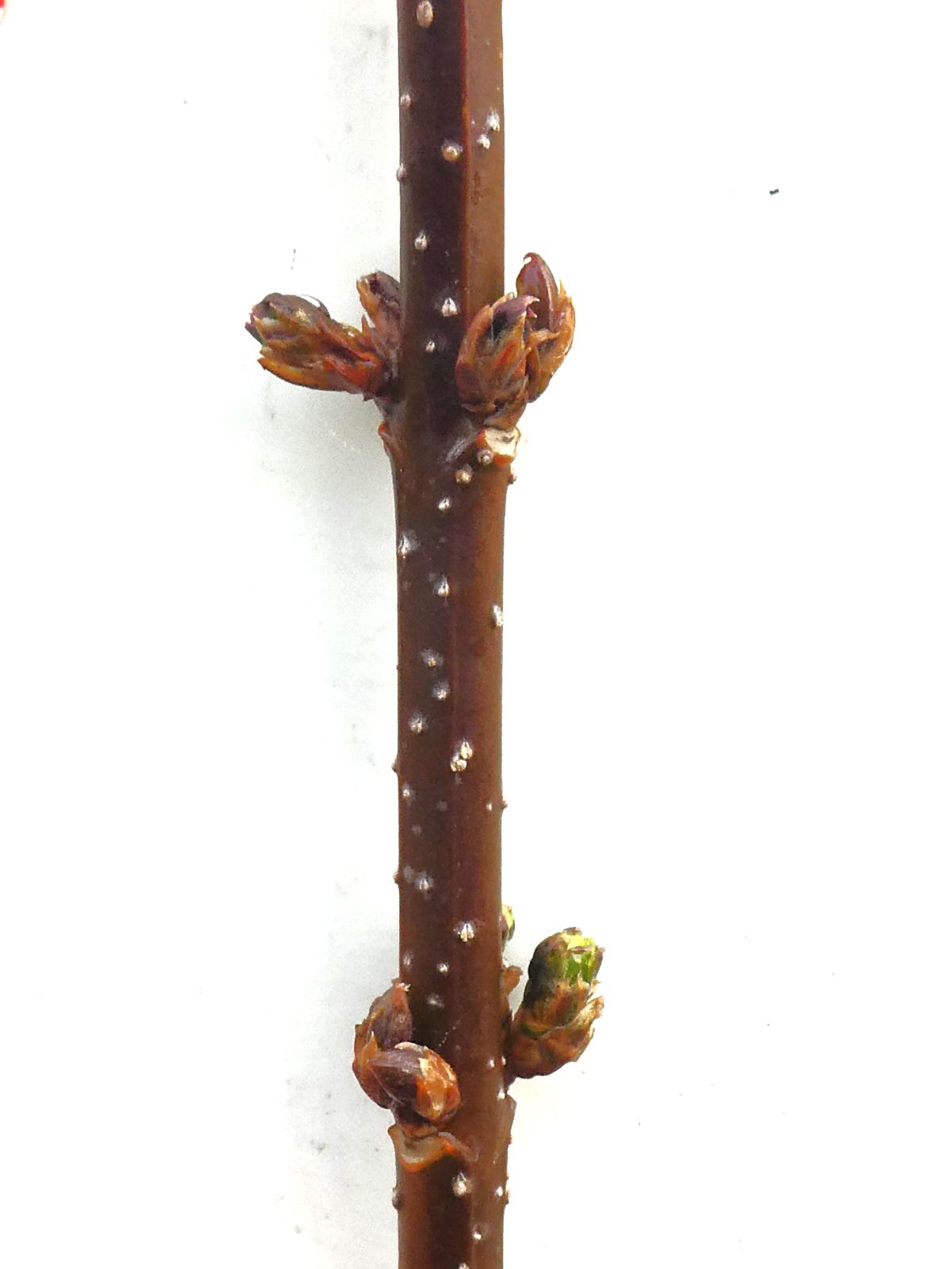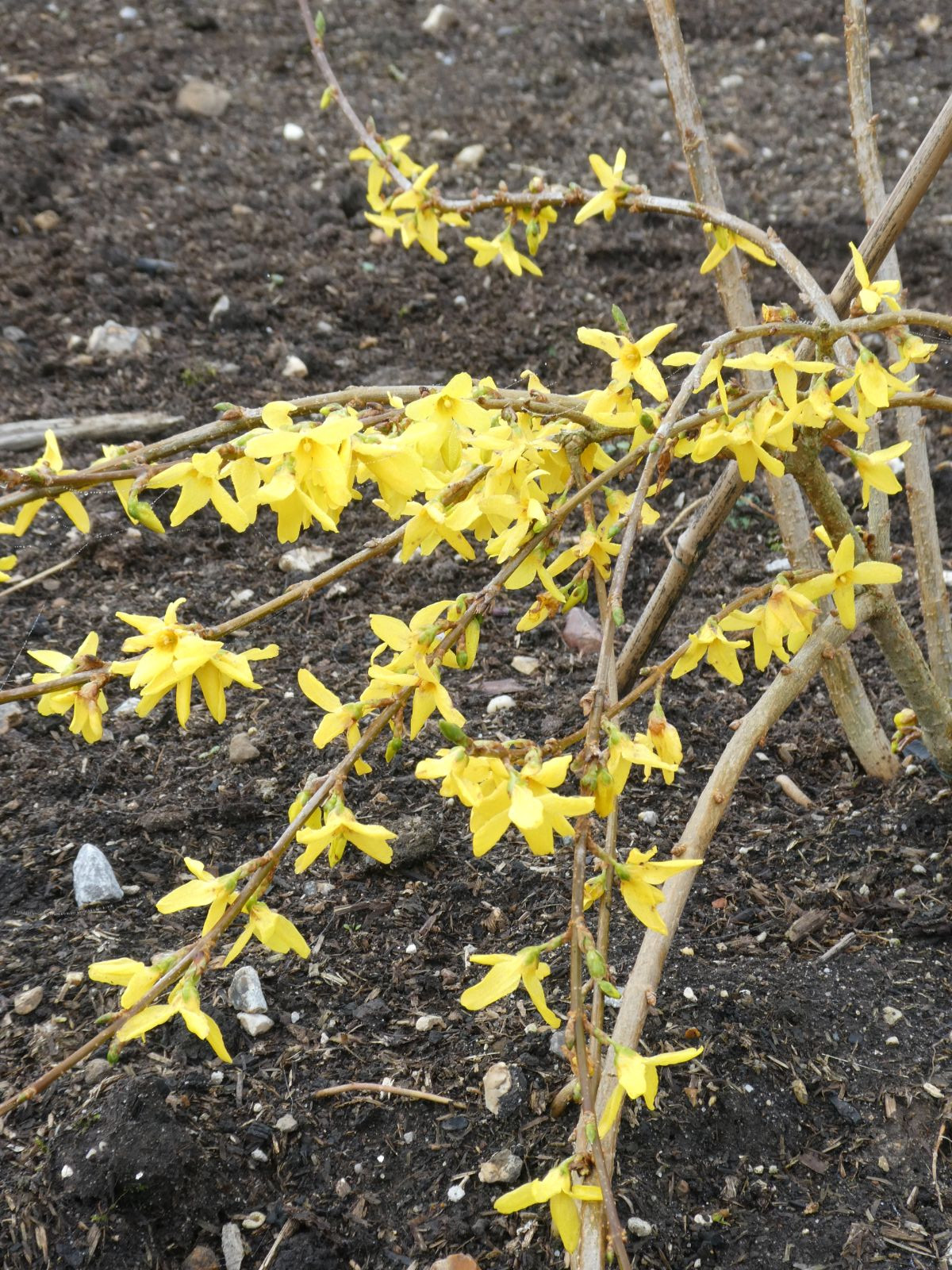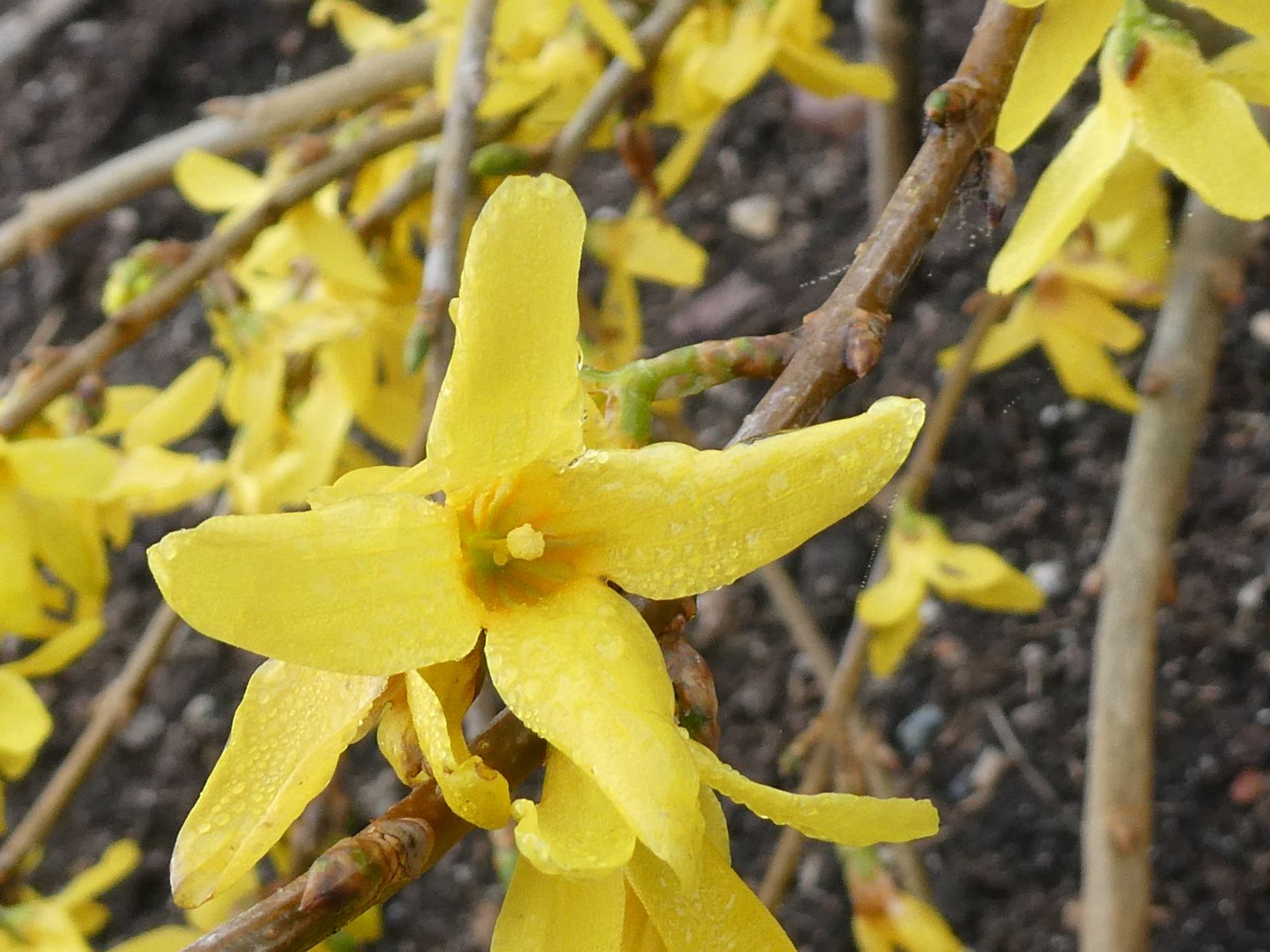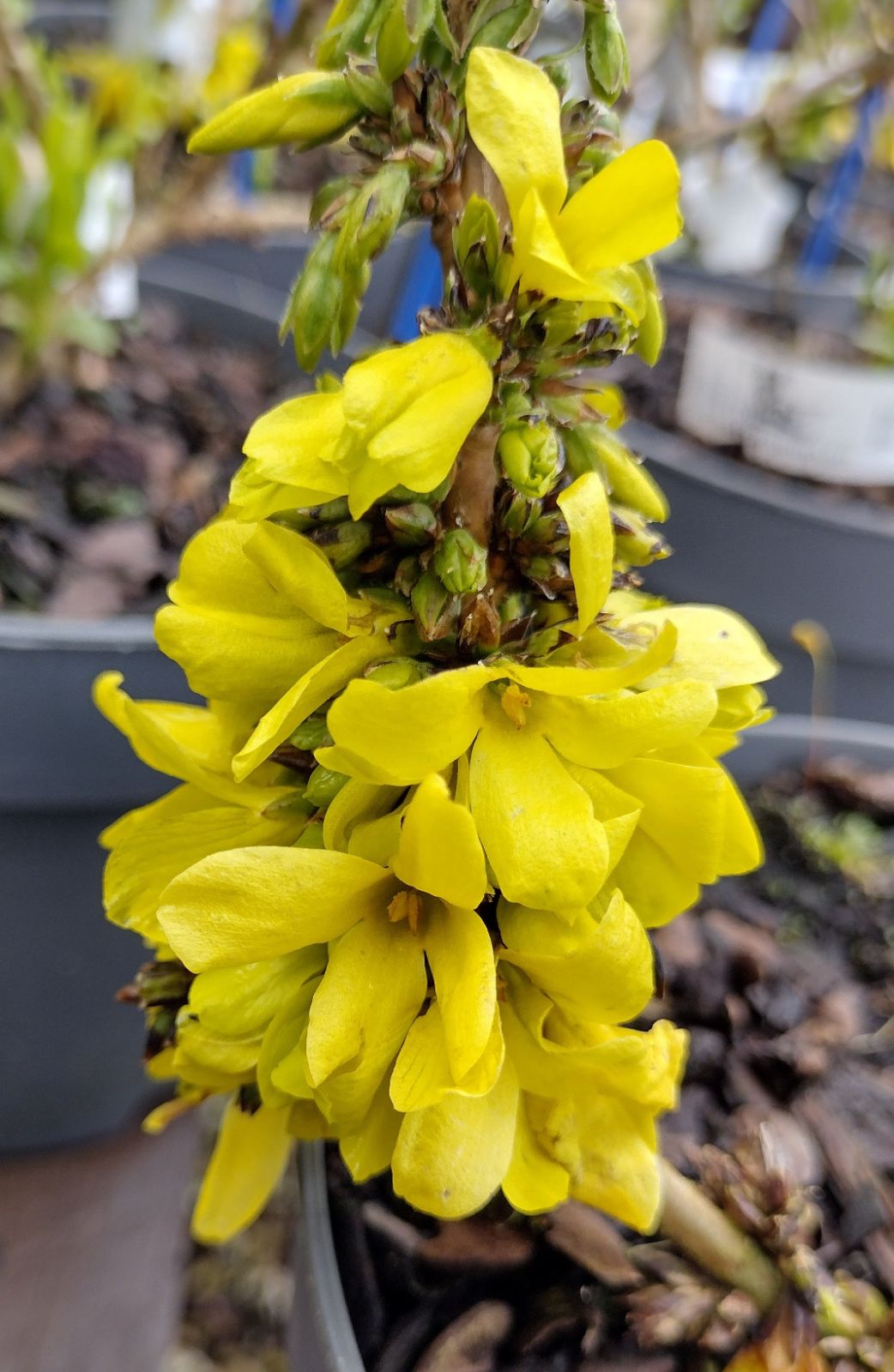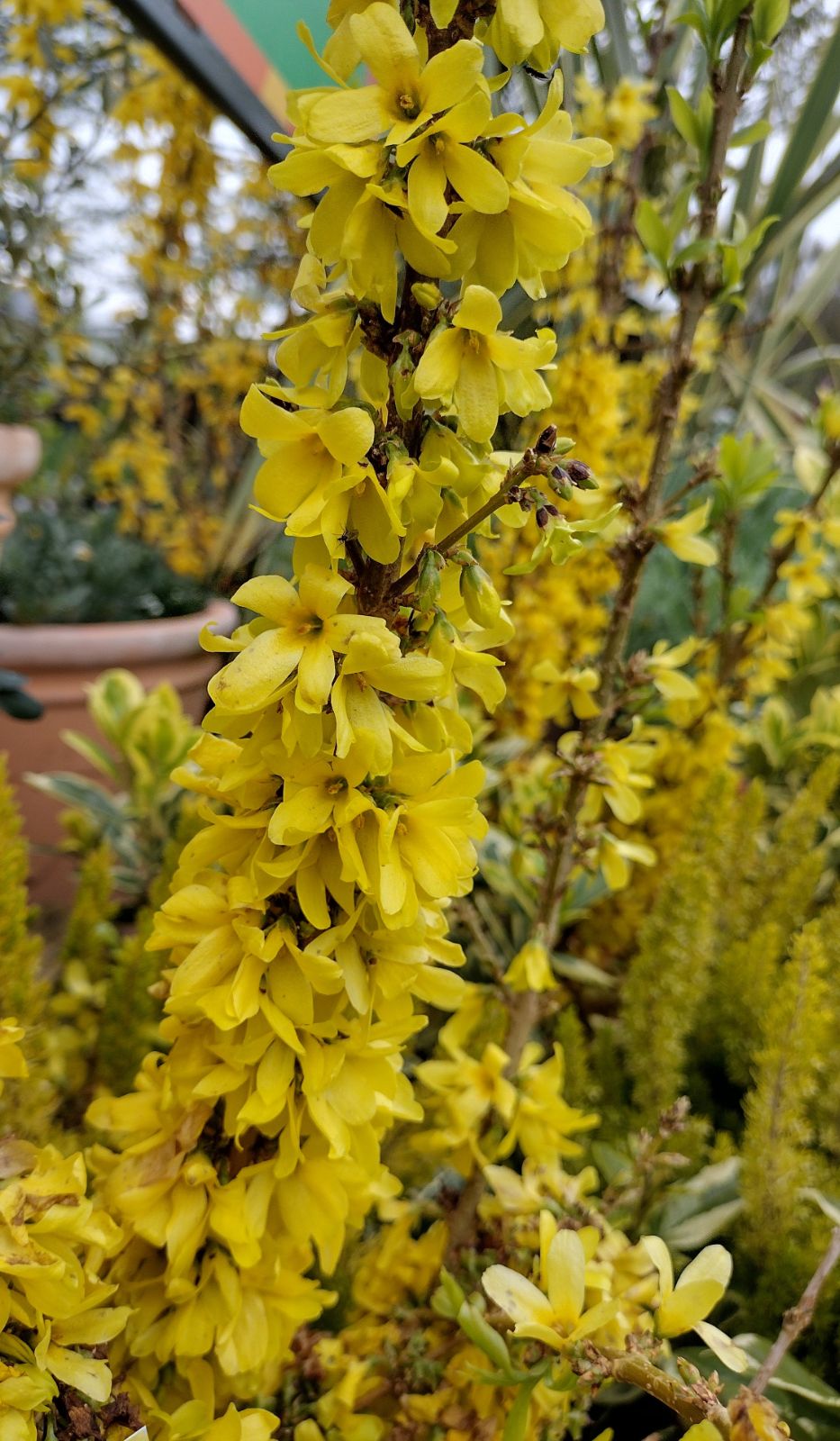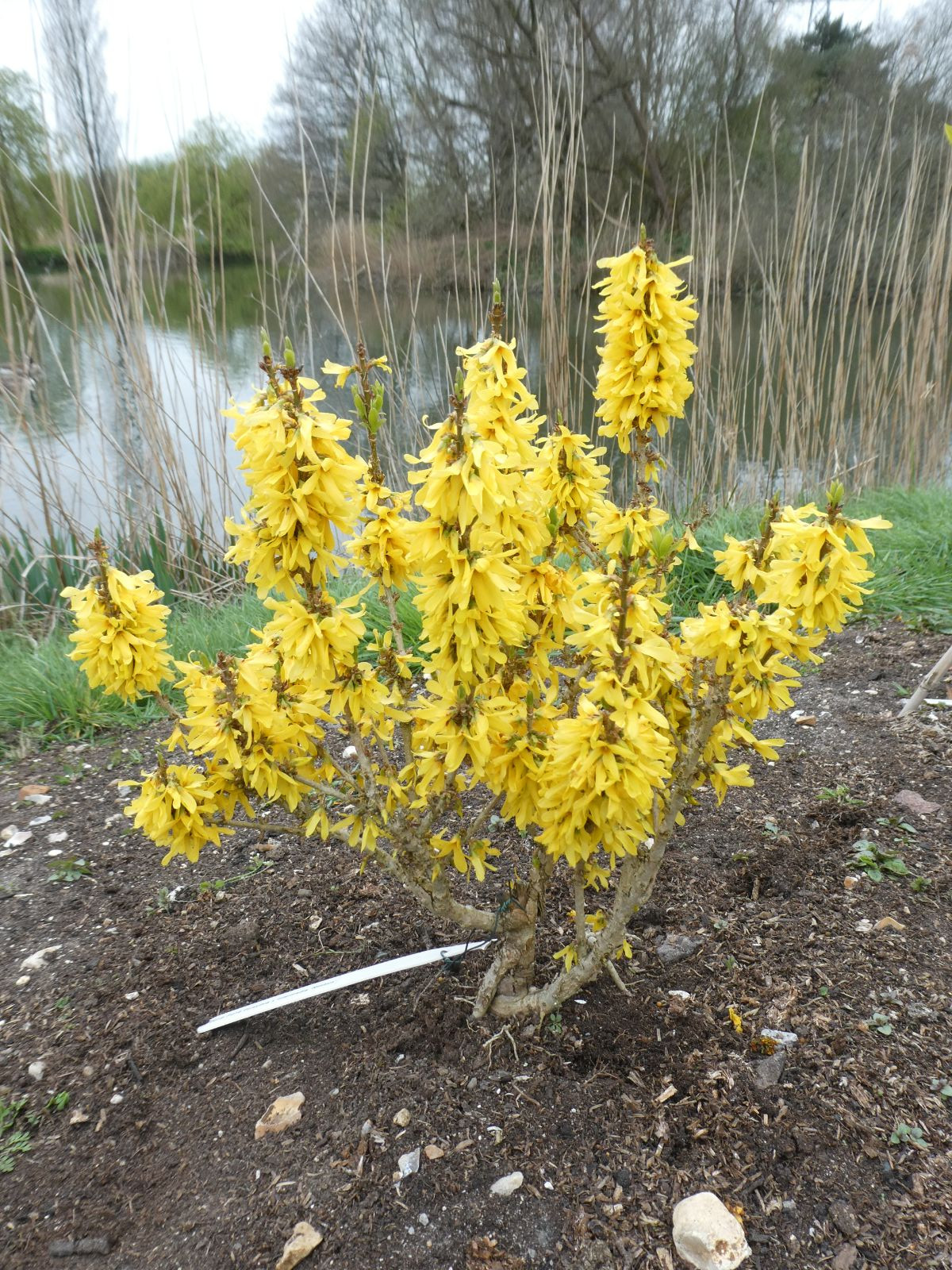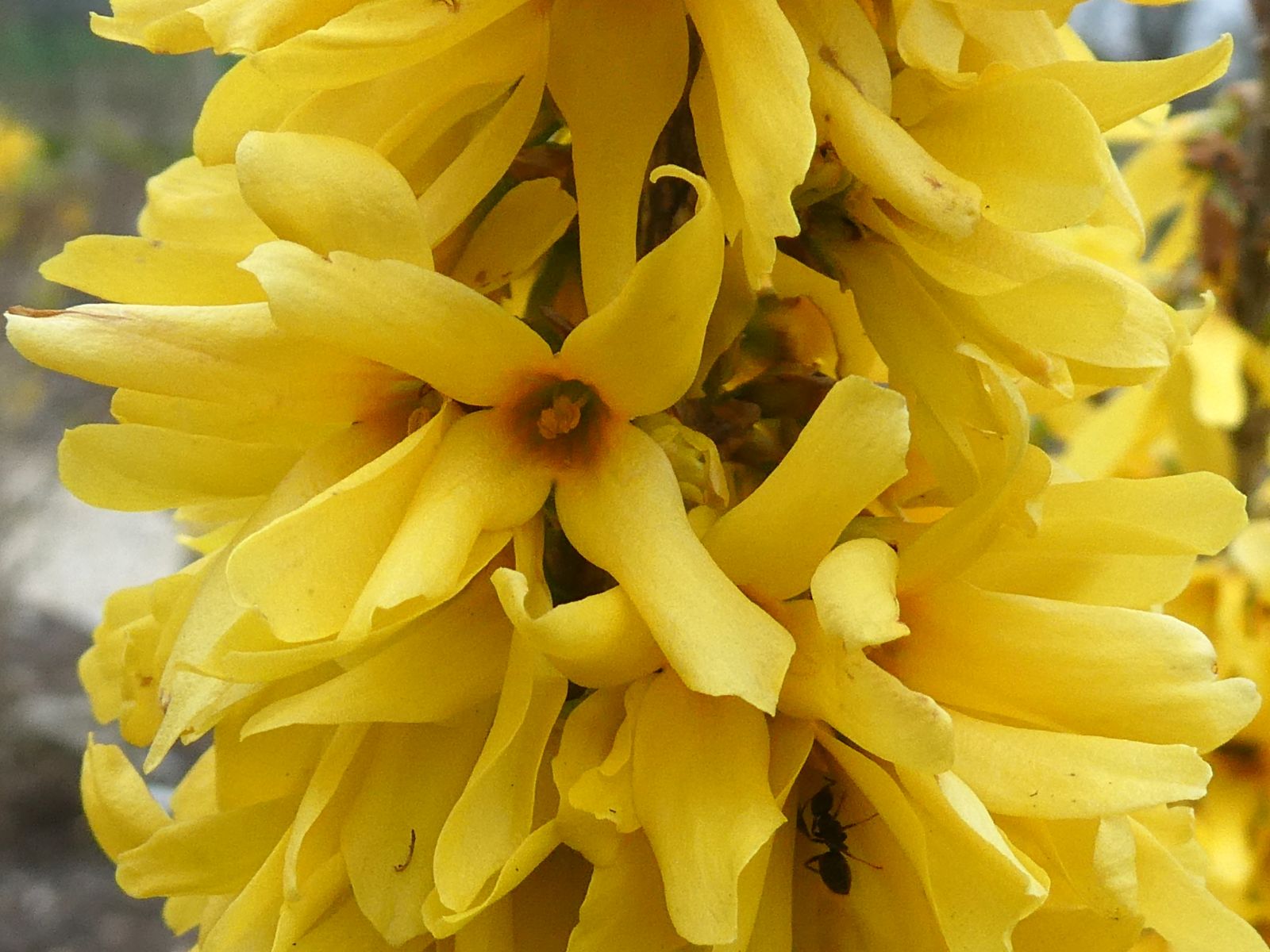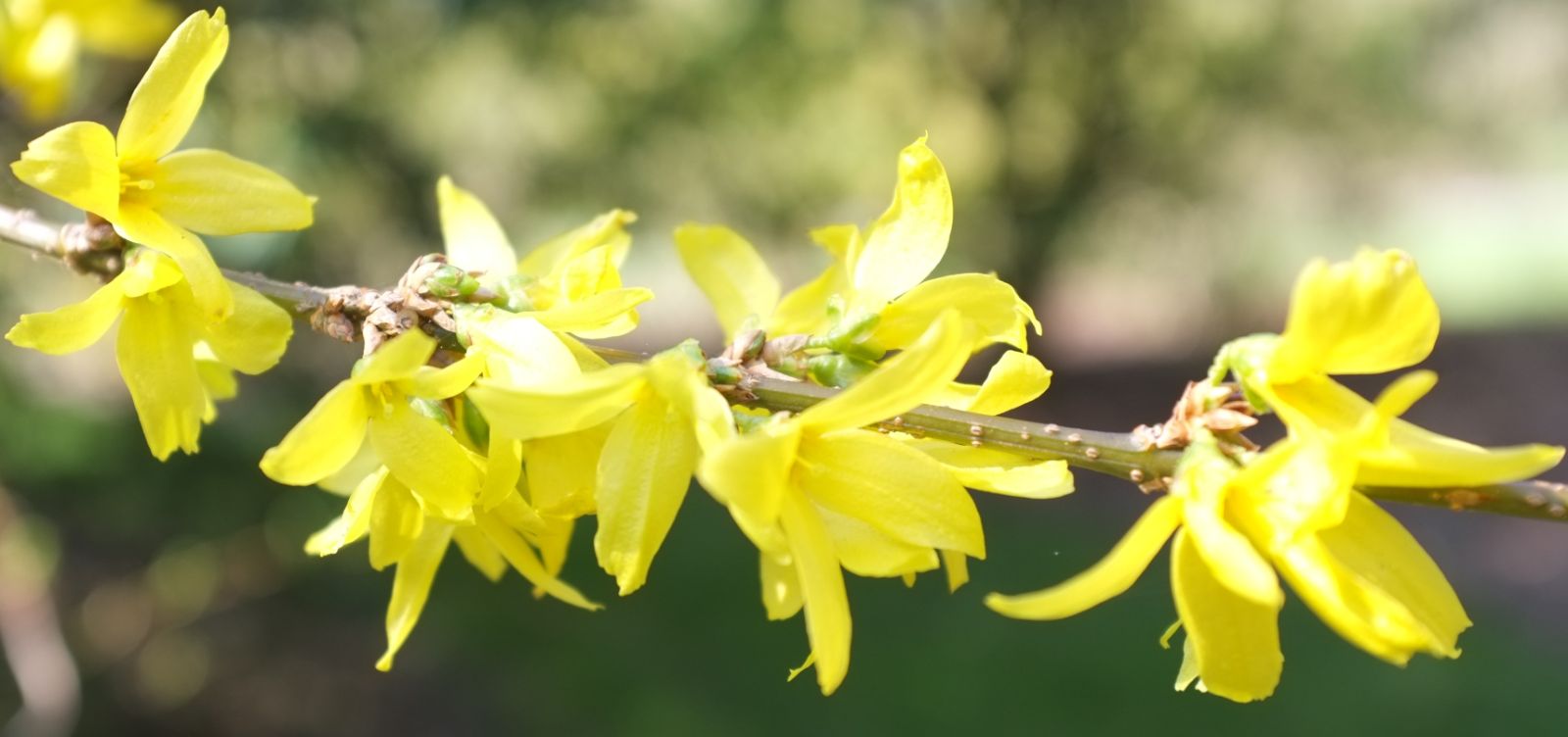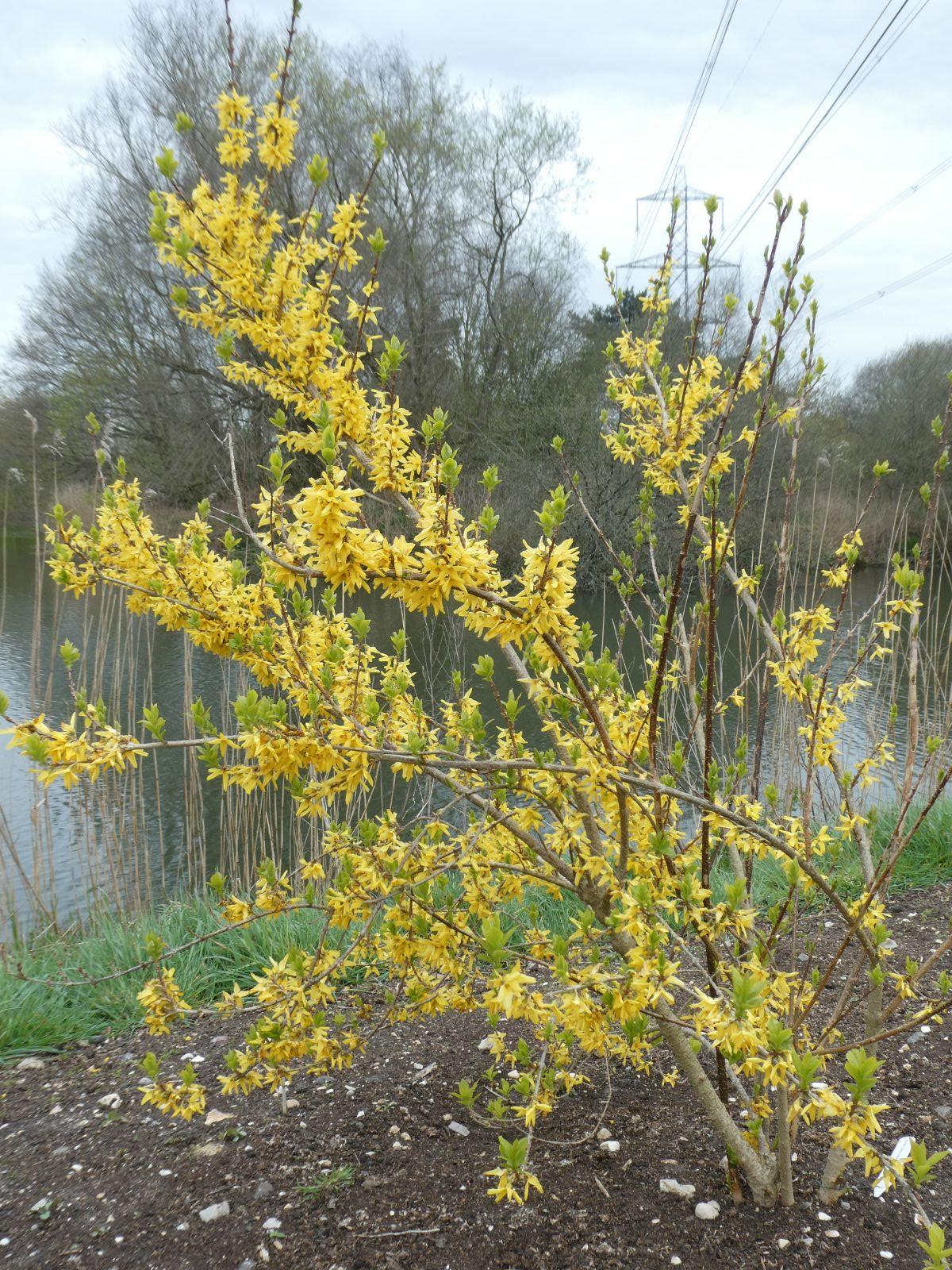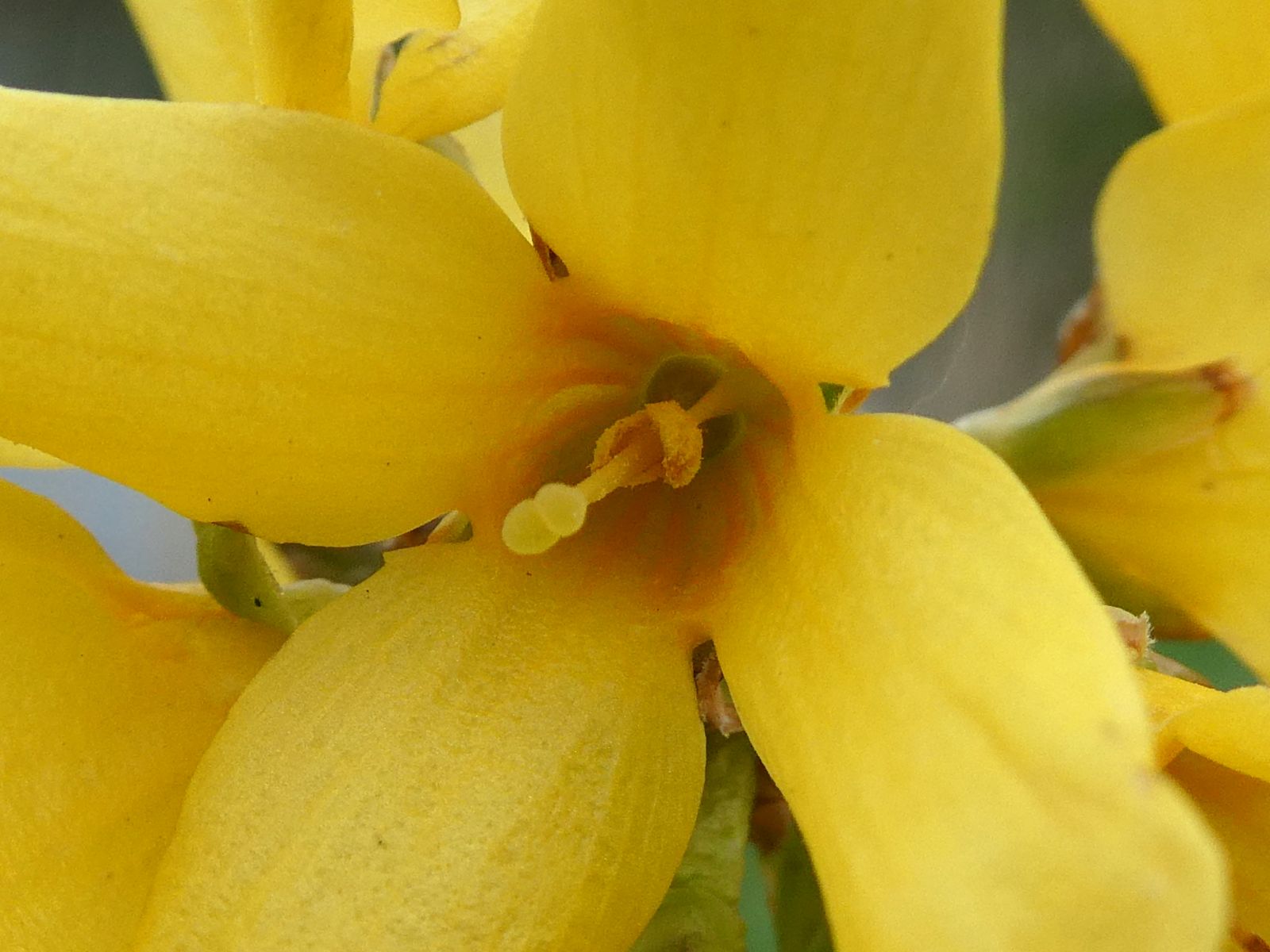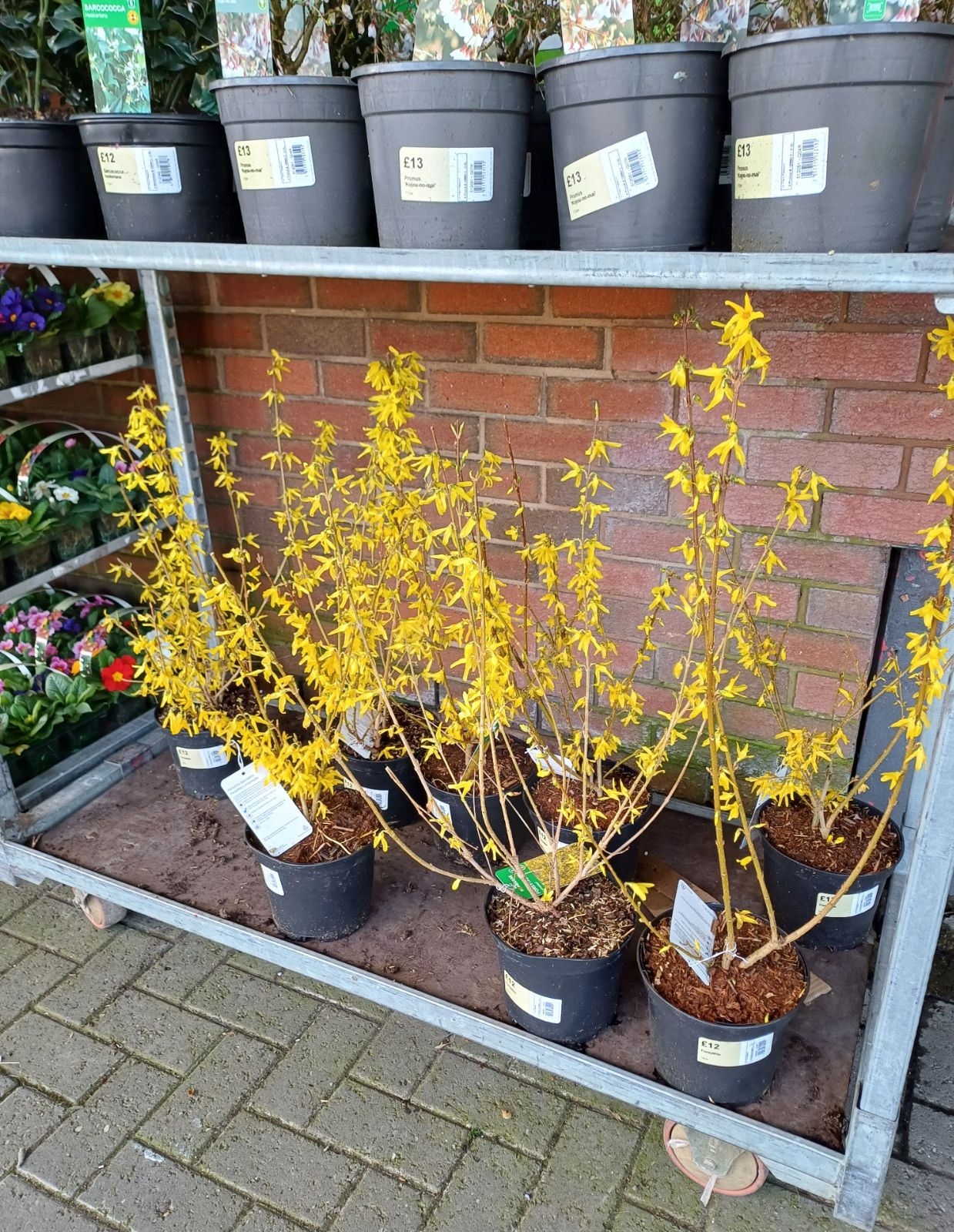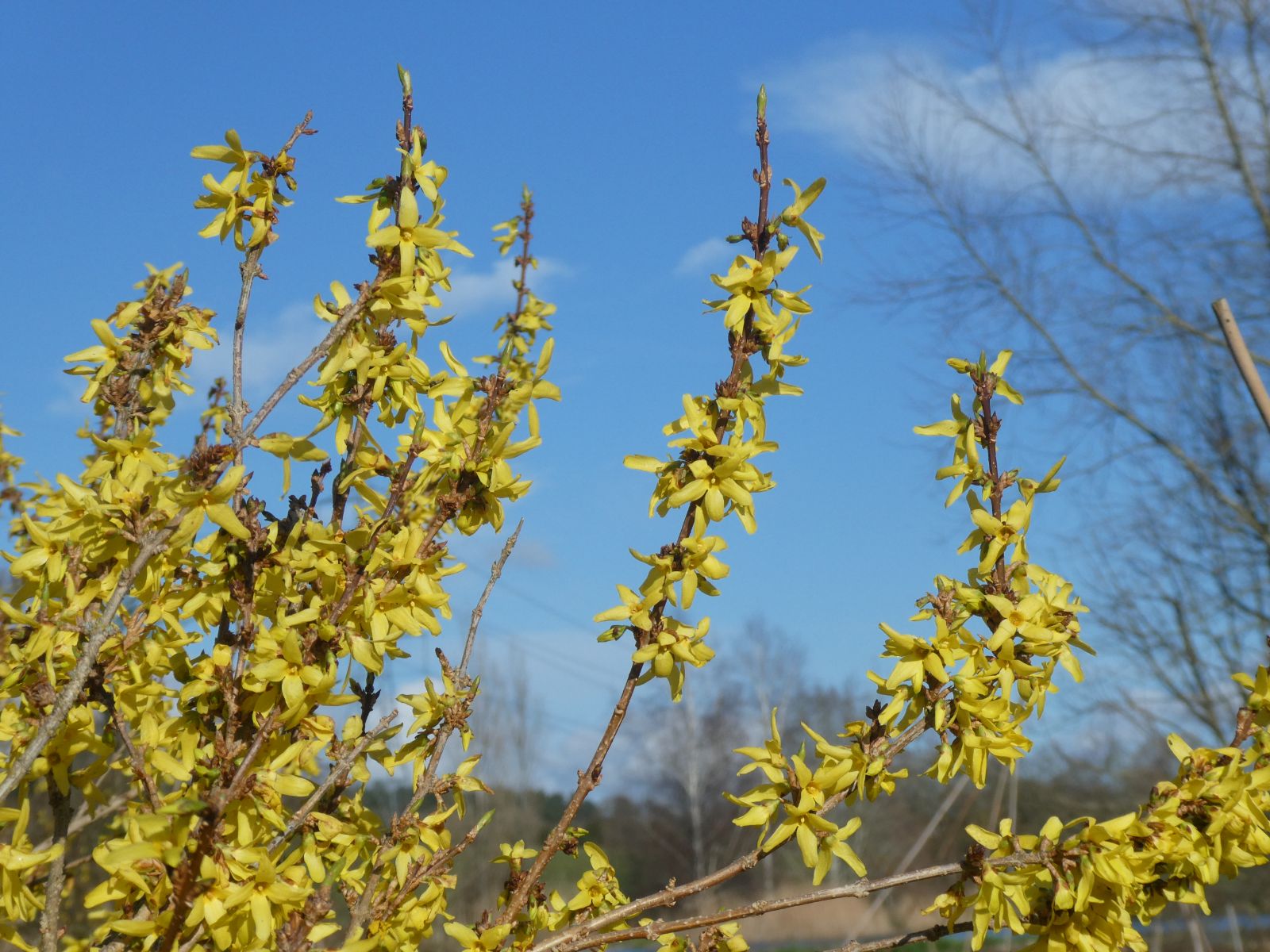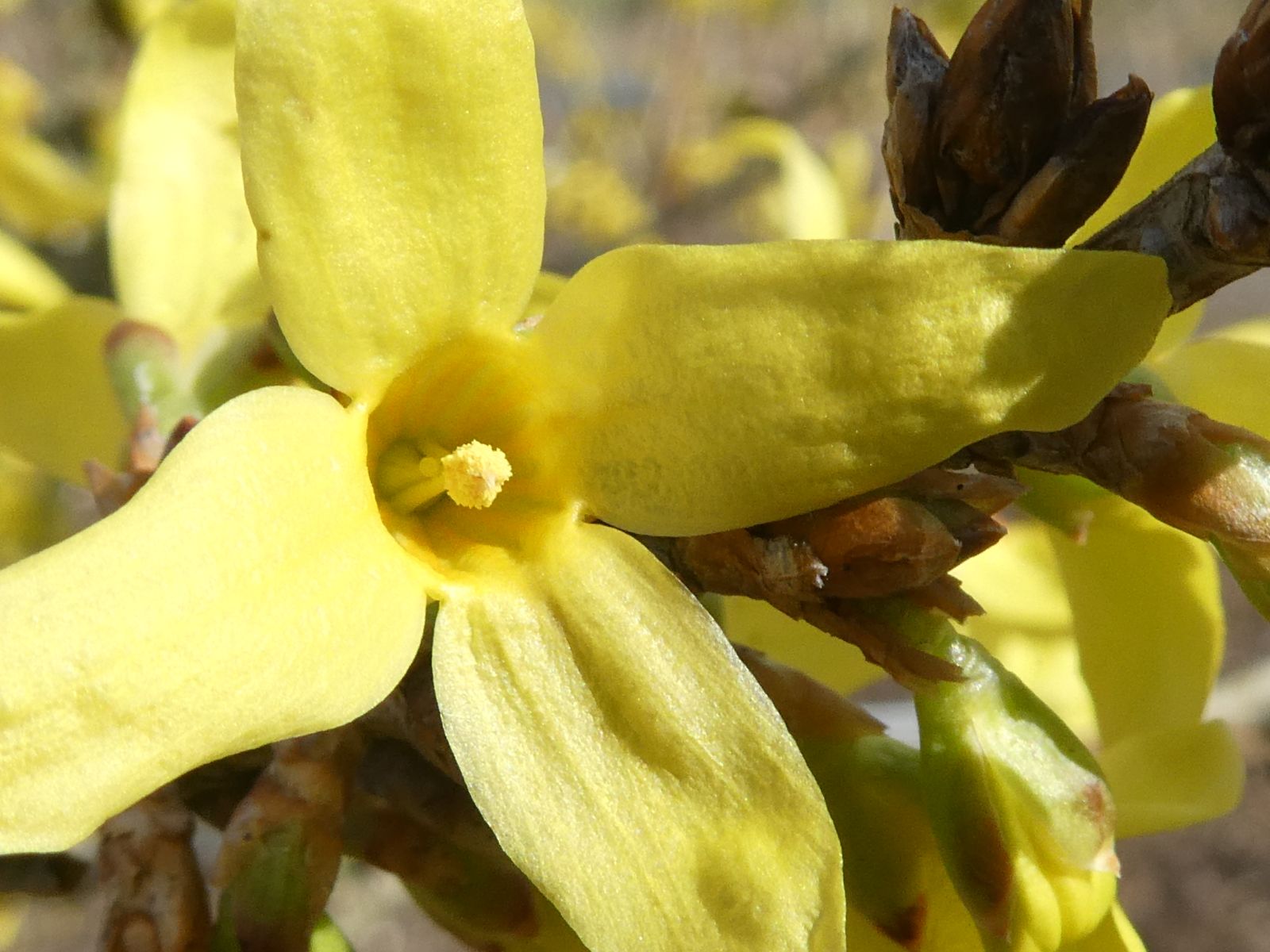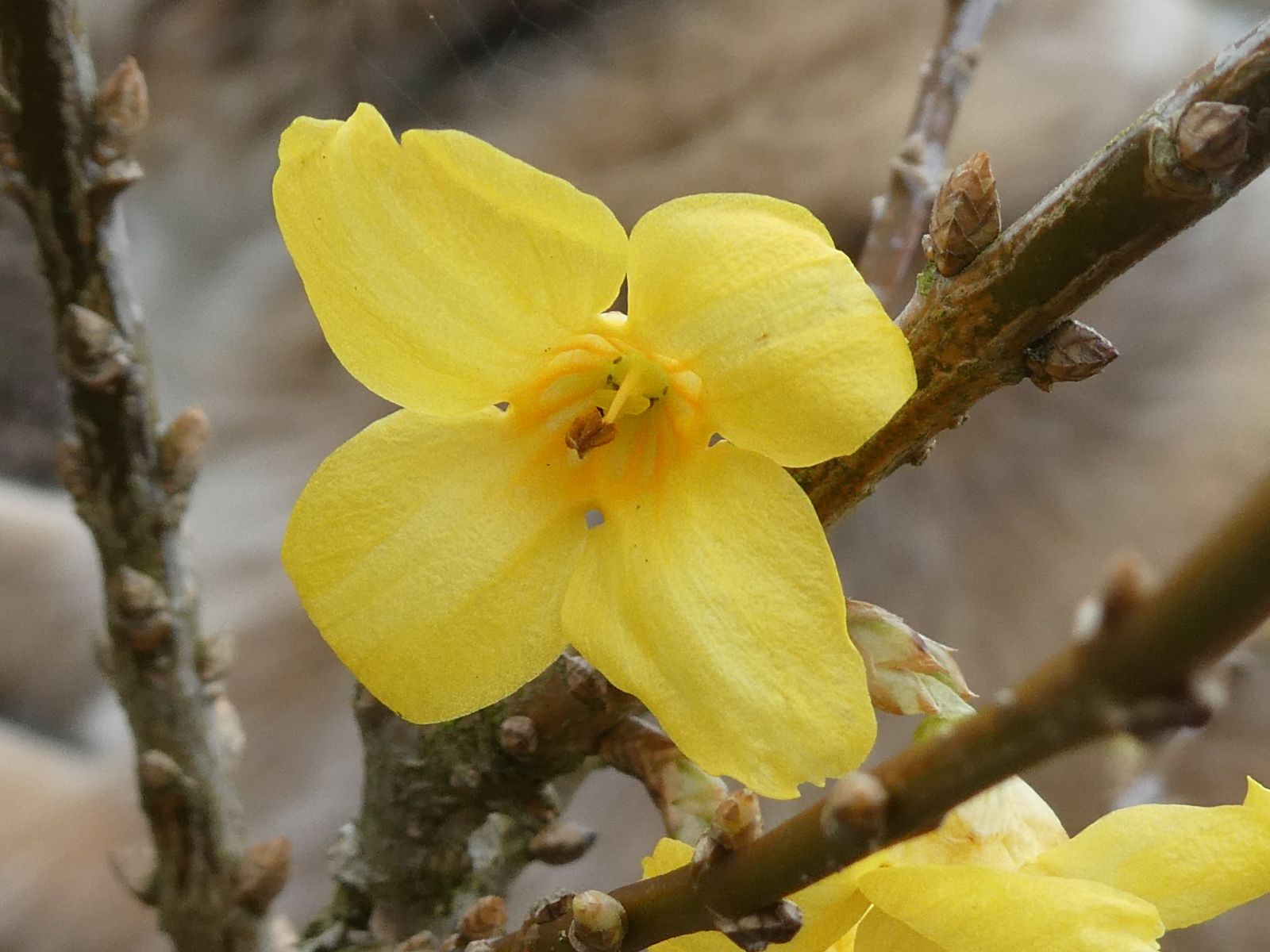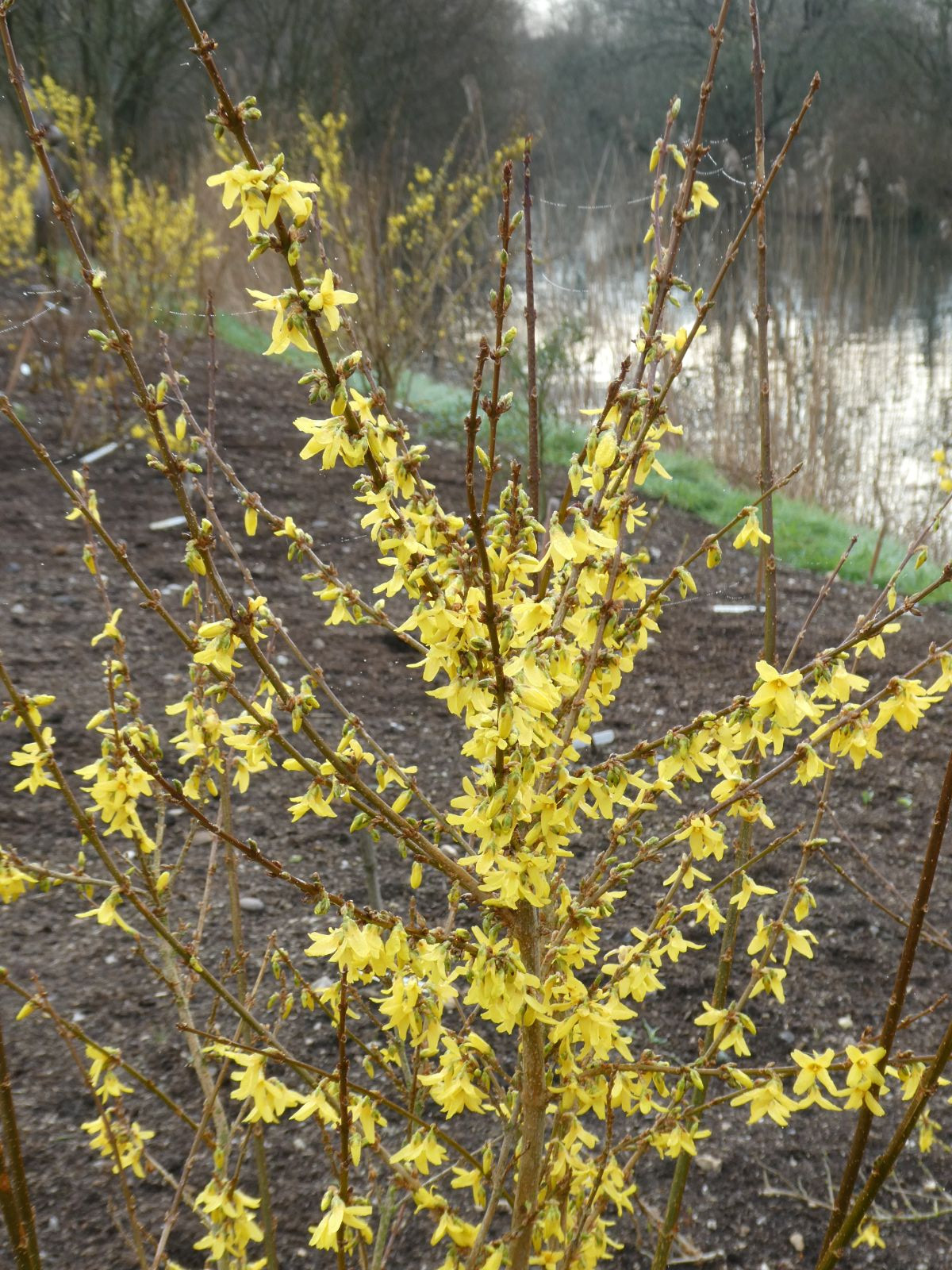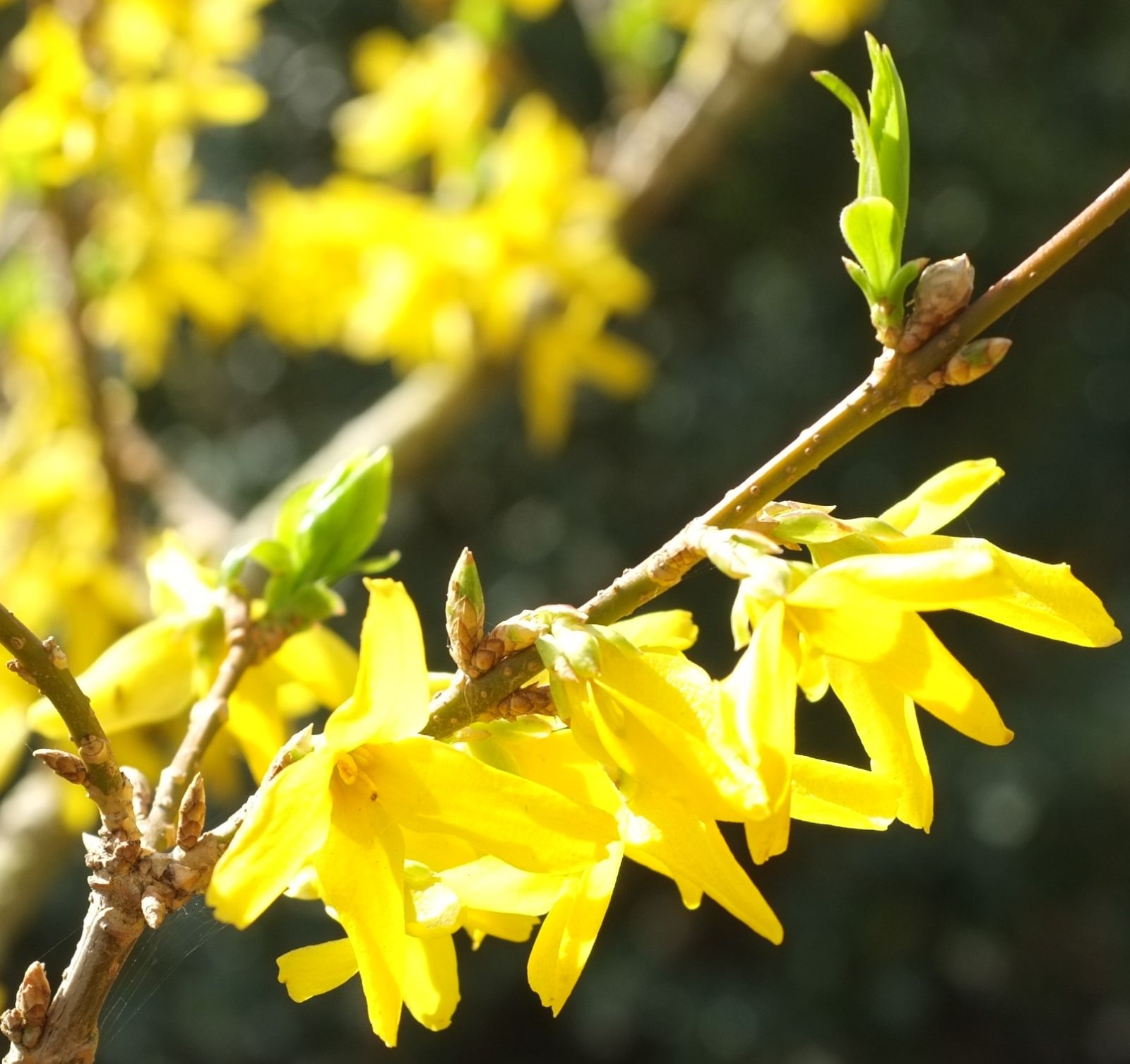Forsythia × intermedia
Sponsor
Kindly sponsored by
Monique Gudgeon, Sculpture by the Lakes
Credits
Owen Johnson (2022)
Recommended citation
Johnson, O. (2022), 'Forsythia × intermedia' from the website Trees and Shrubs Online (treesandshrubsonline.
Genus
- Forsythia
- F. suspensa × F. viridissima
Common Names
- Border Forsythia
- Common Forsythia
Infraspecifics
- 'Arnold Giant'
- 'Ashmount'
- 'Aurea'
- 'Beatrix Farrand'
- 'BJ2013'
- 'Charming'
- 'Clems'
- 'Cole's Glorious'
- 'Courdijau'
- 'Courtacour'
- 'Courtadic'
- 'Courtalyn'
- 'Courtaneur'
- 'Courtasol'
- 'Densiflora'
- 'Discovery'
- 'Evergold'
- 'Fairy-land'
- 'Fiesta'
- 'Flojor'
- 'Golden Fantasy'
- 'Golden Nugget'
- 'Goldleaf'
- 'Goldrausch'
- 'Goldzauber'
- 'Hamden Golden Bells'
- 'Hass Half and Half'
- 'Jehlicovitá'
- 'Josefa'
- 'Karl Sax'
- 'Kolgold'
- 'Lemon Screen'
- 'Liliane'
- 'Lynwood Variety'
- 'Mertensiana'
- 'Mindor'
- 'Minfor6'
- 'Minikin'
- 'Mirabilis'
- 'MNICH01'
- 'Mr K'
- 'Nana'
- 'Nimbus'
- 'Parkdekor'
- 'Phyllis'
- 'Primulina'
- 'Pygmy-Red'
- 'Rebel'
- 'Spectabilis'
- 'Spectabilis Variegated'
- 'Spring Glory'
- 'Susan Gruninger'
- 'Tinkle Bells'
- 'Variegata'
- 'Vitellina'
- 'White Gold'
Other taxa in genus
- Forsythia 'Arnold Dwarf'
- Forsythia europaea
- Forsythia 'Fontanna'
- Forsythia 'Ford Freeway'
- Forsythia giraldiana
- Forsythia 'Gold Splash'
- Forsythia 'Golden Times'
- Forsythia 'Happy Centennial'
- Forsythia 'Helios'
- Forsythia japonica
- Forsythia 'Kanárek'
- Forsythia × kobendzae
- Forsythia koreana
- Forsythia likiangensis
- Forsythia 'Little Renee'
- Forsythia 'Maluch'
- Forsythia × mandshurica
- Forsythia 'Meadowlark'
- Forsythia nakaii
- Forsythia 'New Hampshire Gold'
- Forsythia 'Northern Gold'
- Forsythia 'Northern Sun'
- Forsythia ovata
- Forsythia 'Paulina'
- Forsythia 'Princeton Gold'
- Forsythia 'Robusta'
- Forsythia saxatilis
- Forsythia 'Spring Beauty'
- Forsythia 'Spring Gold'
- Forsythia suspensa
- Forsythia 'Tremonia'
- Forsythia × variabilis
- Forsythia 'Verfors'
- Forsythia viridissima
- Forsythia 'Winterthur'
- Forsythia 'Yatgold'
Shrub with an erect or arching habit, to 5 m tall. Twigs greenish to bright brown, with raised lenticels; pith irregularly laminate and/or solid at the nodes. Leaves ovate to broad-lanceolate, 4–10 × 2–5 cm, rarely deeply 3-lobed to trifoliate on strong shoots, variably toothed. Flowers rarely carried singly, or more often in pairs or clusters of up to 6 at each leaf-scar, not scented. Calyx more than half as long as the corolla tube and sometimes as long. Corolla bright yellow, to 4 cm wide, with oblong lobes often revolute and twisted. Fruit-pods usually empty. (Bean 1981).
USDA Hardiness Zone 5
RHS Hardiness Rating H6
The two Forsythia species cultivated in Europe and America through the second half of the 19th century, F. suspensa and F. viridissima, were first experimentally crossed by Thomas Meehan at Germanstown in Pennsylvania in the 1860s (Bean 1981) (Wikipedia 2021), but the seedlings may not have succeeded and never became commercially available. In 1878, the German dendrologist Hermann Zabel noted seedlings in the Old Botanic Garden of Göttingen University which were intermediate between F. suspensa and F. viridissima, and described the presumed hybrid in 1885 (Dirr 2009). Doubt was cast on the origins of F. × intermedia by Ki-Joong Kim’s phylogenetic study of the genus in 1999, since his results did not suggest that it was genetically intermediate between F. suspensa and F. viridissima or even closely allied to these species, but more recent and sophisticated studies have effectively confirmed its hybrid status (Ha et al. 2018).
The first named clones of the German hybrids were distributed by Späth of Berlin from 1899, with one, ‘Spectabilis’, quickly gaining favour as the most floriferous and adaptable member of its genus. Since then, numerous selections have been named, most of them simply seeking to improve on ‘Spectabilis’ in terms of hardiness, habit, flower-size and general reliability; it is likely that several more of the Forsythia clones of unknown parentage, which are treated in this account as cultivars of the genus itself, really belong under F. × intermedia.
There are a number of named variegated clones of F. × intermedia. Some are sufficiently distinct and widespread to merit their own entries here, while others are barely more than names; an informal checklist is given under ‘Variegata’.
'Arnold Giant'
In the late 1930s Dr Karl Sax of the Arnold Arboretum in Massachusetts experimented with inducing polyploidy in Forsythia × intermedia ‘Spectabilis’ through the use of colchicine toxins; polyploids can be vigorous with very large flowers, and can be self-fertile. ‘Arnold Giant’, a tetraploid named in 1939, is tall upright plant with large, thick and dark leaves and very big flowers, but these are less abundantly produced and the plant is not so easy to raise from cuttings as most Forsythias, so it has never become popular (Bean 1981).
- ‘Arnold Brilliant’ Sold by the Tingle Nursery,Maryland, in 1959 presumably as a clone selected at the Arnold Arboretum, but perhaps synonymous with one of the better-known Arboretum forms such as ‘Arnold Giant’ (Dirr 2009)
'Ashmount'
Synonyms / alternative names
Forsythia × intermedia 'Ashmount Gold'
A compact clone with arching or weeping shoots (Esveld Nursery 2022), probably selected by John Ravensberg at Ashmount House, Clara, Ireland.
'Aurea'
A yellow-leaved sport with pale yellow flowers, found at the Beardslee Nursery in Ohio and sold by 1958 (Dirr 2009). The latinate name is probably illegitimate.
'Beatrix Farrand'
‘Beatrix Farrand’ is perhaps the name under which the greatest proportion of forsythias have been sold in the United States, so it is unfortunate that the history of this clone – or group of clones – has over the space of 75 years become so extraordinarily confused.
What is known for certain is that the original ‘Beatrix Farrand’ was bred at the Arnold Arboretum by Karl Sax and his students in 1944, and was named ‘Farrand’ after the Arboretum’s Landscape Consultant, Beatrix Farrand. The name was changed to ‘Beatrix Farrand’ at Mrs Farrand’s request (Wyman 1961).
The most significant source of confusion concerns this plant’s parentage; two accounts published ten years apart in the Arboretum’s magazine, Arnoldia, under confusingly similar titles, ought to be definitive in this respect but instead give quite different accounts. In ‘The Forsythia Story’ in 1961, Donald Wyman (Wyman 1961) states that this group of seedlings were hybrids between F. × intermedia ‘Arnold Giant’ and F. ovata; this account is followed by The Hillier Manual of Trees and Shrubs (Edwards & Marshall 2019) and presumably informs the Royal Horticultural Society’s nomenclatural decision to treat ‘Beatrix Farrand’ as an unattributed cultivar of Forsythia, not of F. × intermedia. But in ‘The Story of Forsythia’ in 1971, Gorden DeWolf and Robert Hebb (DeWolf & Hebb 1971) state that the group of seedlings were ‘Arnold Giant’ back-crossed with F. × intermedia ‘Spectabilis’ (and thus ‘pure’ F. × intermedia); this account is followed by Trees and Shrubs Hardy in the British Isles (Bean 1981). Genetic analyses by Ki-Joong Kim in 1999 of two plants received as ‘Beatrix Farrand’ (Kim 1999) seemed to show them nested comfortably among his samples from other F. × intermedia clones, including ‘Spectabilis’ itself; this account consequently assumes that the second parent was indeed ‘Spectabilis’.
A second source of confusion surrounds the question of whether the plants sold as ‘Beatrix Farrand’ today are the same plant that was originally distributed by the Arnold Arboretum, and whether in fact they still represent a single clone. Laurence Hatch (Hatch 2021–2022) states that of Sax’s seedlings, no. 13 was named as ‘Farrand’ and was tetraploid, but that no. 6, a triploid plant, also came to be sold as ‘Beatrix Farrand’. This has an air of authenticity but is unfortunately not referenced, and directly contradicts the first account published in Arnoldia (Wyman 1961) in which Wyman states that the plant named ‘Farrand’ was triploid. Research by G.E. Marks and K.A Beckett, published in the Journal of the Royal Horticultural Society in 1963 and cited by Peter Green in Trees and Shrubs Hardy in the British Isles (Bean 1981), indicated that the plants sold as ‘Beatrix Farrand’ in the UK at the time were all tetraploid (and produce fertile seed); they were rather unfortunately thrum-eyed (or ‘male’), and had bluish-green, very coarsely toothed leaves and a vigorous, erect habit. Green’s account rather grudgingly describes this plant as ‘quite handsome in flower, but the foliage is ugly and the habit gaunt.’ Michael Dirr (Dirr 2009) suggests that the plant familiar to him in the United States as ‘Beatrix Farrand’, with large brilliant yellow flowers, might differ from the plant described by Green.
The Royal Horticultural Society’s Plant Finder (RHS 2020) attempts to distinguish plants sold in the UK ambiguously as ‘Beatrix Farrand’ from a ‘true’ clone, for which the name F. ‘Beatrix Farrand’ (K. Sax) is recommended; this should not be – but probably has been and will be – confused with F. × intermedia ‘Karl Sax’. The 2020 edition lists three suppliers of F. ‘Beatrix Farrand’ (K. Sax) but, given the continuing confusion which surrounds this plant (or, indeed, these plants) any attempts to distinguish true from false forms seem redundant. DeWolf and Hebb propose the use of the name ‘Farrand Hybrids’ (DeWolf & Hebb 1971), but this would cover all the hybrids raised at the Arnold Arboretum in 1944, including the apparently distinct and genuine ‘Karl Sax’.
'BJ2013'
A sport arising in 2013 in Pennsylvania, USA; flowers small but abundant; dark-green leaves very variably blotched and speckled with yellow-green fading to whitish (Hatch 2021–2022).
'Charming'
A sport of ‘Lynwood Variety’ with variegated foliage, raised in Germany before 1976 (Hatch 2021–2022). The plant sold in the UK in 2020 by MacPennys Nursery as ‘Lynwood Variety variegated’ may represent the same sport; see ‘Variegata’ for a discussion of all the variegated selections of F. × intermedia.
'Clems'
Synonyms / alternative names
Forsythia × intermedia CLEMS YELLOW LEAF FORSYTHIA™
A branch-sport raised in the 1980s by Clarence Hassinger at Clems Nursery, Pennsylvania, with yellow young leaves, contrasting with the dark green of the older foliage (Dirr 2009). It may no longer be commercially available.
'Cole's Glorious'
Included in the Chicago Botanic Garden’s near-comprehensive check-list of taxa, without further details (Chicago Botanic Garden 2020).
'Courdijau'
Synonyms / alternative names
Forsythia × intermedia CASQUE D'ORPBR
Forsythia × intermedia GOLDEN PEEPPBR
One of the miniature forsythias raised by Luc Decourtye in France from the 1970s; it combines a densely globular habit (to 1 m tall) with profuse spring blossom (Stewart 2021). ‘Courdijau’ was introduced to the United States in 2002 (Missouri Botanical Garden 2022), and in the continental climate of Wisconsin shows good autumn colour.
'Courtacour'
Synonyms / alternative names
Forsythia × intermedia BOUCLE D'OR
Forsythia × intermedia GOLDILOCKS™
One of the smallest of Luc Decourtye’s forsythias, bred in France in the 1970s from irradiated seed of ‘Spring Glory’ (Dirr 2009). Its slow growth, to a maximum height of about 50 cm, suit it for a rockery or container (Edwards & Marshall 2019), though the habit can be slightly gaunt (Hatch 2021–2022); rich golden-yellow flowers densely wreathe the shoots. Autumn colour can be purple (Stewart 2021).
'Courtadic'
Synonyms / alternative names
Forsythia × intermedia MELISA™
A ‘pin-eyed’ product of Luc Decourtye’s 1970s breeding programme in France, sometimes advertised as suitable for ground-cover but, at Sculpture by the Lakes in Dorset, quite upright as a young plant. The sale-name often appears as ‘Melissa’, but is given as MELISA in Alain Cadic’s seminal account of Decourtye’s hybrids (Cadic 1988).
'Courtalyn'
Synonyms / alternative names
Forsythia × intermedia WEEK ENDPBR
Awards
AGM
Still a popular clone in the early 2020s, ‘Courtalyn’ was raised in France by Luc DeCourtye in the 1970s as a mutation of ‘Lynwood’ (Edwards & Marshall 2019); it has a rather tidier habit but is more vulnerable to Forsythia Gall (Marks 2021). It is one of the last F. × intermedia forms to flower (Hatch 2021–2022) and in a continental climate its dark green leaves turn bronze in autumn (Stewart 2021). The sale name is often modified to ‘Week-end’ or ‘Weekend’. It is a ‘thrum-eyed’ plant.
'Courtaneur'
Synonyms / alternative names
Forsythia × intermedia MELÉE D'OR
Forsythia × intermedia GOLD MIX
Forsythia × intermedia GOLD CLUSTER™
A popular product of Luc Decourtye’s forsythia breeding programme: a compact upright plant to 1 m tall, producing its clear yellow flowers a week before ‘Lynwood Variety’. The leaves, which are sometimes untoothed, can turn red in autumn (Edwards & Marshall 2019).
'Courtasol'
Synonyms / alternative names
Forsythia × intermedia MARÉE D'ORPBR
Forsythia × intermedia GOLD TIDE™
Awards
AGM
One of the most commercially successful of Luc Decourtye’s forsythias, bred in France in the 1970s as a mutation of ‘Spring Glory’ (Dirr 2009). It is a low, dense plant with gracefully arching shoots, suitable for ground cover; the lemon-yellow flowers are early and abundant, and the foliage is a particularly attractive soft moss-green, and can turn reddish in autumn (Edwards & Marshall 2019). As Laurence Hatch has remarked (Hatch 2021–2022), here for once is a forsythia which would be worth growing even if it never flowered at all.
'Densiflora'
Synonyms / alternative names
Forsythia × densiflora Koehne (Koehne)
Forsythia × intermedia var. densiflora Koehne
One of the very first hybrid forsythia clones to be sold, in 1899 by Späth of Berlin (Bean 1981). It is ‘pin-eyed’, has a drooping habit, and its large (c. 32 mm wide) soft-yellow flowers have lobes less revolute than in many of the hybrids. As they naturally perpetuate themselves by rooting stems, forsythias can be very long-lived shrubs, and the plant purchased in 1903 by the Royal Botanic Garden Edinburgh is still there (Royal Botanic Garden Edinburgh 2022).
'Discovery'
Synonyms / alternative names
Forsythia × intermedia JOHN MITCHELL
Released by the Hillier Nurseries in 2022, ‘Discovery’ is a new variegated clone that was discovered in an Oxfordshire (UK) garden in 2007. Its trade designation commemorates John Mitchell, a first officer in the UK Merchant Navy; the RSS Discovery was one of the last ships he served on (hillier.co.uk).
'Evergold'
A variegated sport sold by the Head-Lee Nursery in South Carolina; the leaves have a rich yellow margin whose colour does not fade in the hot summers of the south-eastern United States (Dirr 2009).
'Fairy-land'
A miniature forsythia raised by Hendrick van der Werken at the University of Tennessee at Knoxville by irradiation of ‘Lynwood Variety’. The flowers can have as many as eight lobes (Dirr 2009).
'Fiesta'
Synonyms / alternative names
RHS Hardiness Rating: H7
USDA Hardiness Zone: 4b
‘Fiesta’ seems to be the only forsythia selection to have originated in Australasia; it arose at the Duncan and Davies nursery in New Zealand, apparently as a sport of ‘Lynwood Variety’ (though the name is often given as simply F. ‘Fiesta’). It is shy-flowering but carries leaves brightly blotched in their centres in yellow-green and cream (Dirr 2009), on reddish stems (Hatch 2021–2022), and makes a compact bush (Edwards & Marshall 2019). For all its origins, it is as hardy as most forsythias, surviving in St Paul, Minnesota (USDA hardiness zone 4b) (Dirr 2009). Like the parent plant, it is a ‘thrum-eyed’ clone.
- ‘Festival’ Grown in the Winter Garden at the Sir Harold Hillier Gardens, England (Royal Botanic Garden Edinburgh 1997), this is assumed to be a renaming of ‘Fiesta’.
- ‘Minigold Fiesta’ Plants grown under this name may represent a subtly different form (Hatch 2021–2022). However it may also be likely that confusion has arisen with F. × intermedia ‘Flojor’, a dwarf clone from France with green leaves which has been distributed in English-speaking countries under the sale-name MINIGOLD.
'Flojor'
Synonyms / alternative names
Forsythia × intermedia MINIGOLD
A dwarf forsythia bred in France in the 1980s by irradiation of ‘Vitellina’ (Cadic 1988), growing to about 1 m. The abundant flowers are small but have broad lobes (Edwards & Marshall 2019) and are ‘thrum-eyed’. The sale-name often appears as ‘Mini Gold’.
'Golden Fantasy'
A large-flowered selection from Kolster BV in the Netherlands (Kolster nurseries 2022). It may not belong within Forsythia × intermedia.
'Golden Nugget'
‘Golden Nugget’ was raised at the Hillier Nurseries in 1964 by Alf Alford, by back-crossing a plant grown as ‘Beatrix Farrand’ with ‘Arnold Giant’. It is a vigorous plant with flowers as much as 5 cm wide, occasionally with six-lobed corollas (Edwards & Marshall 2019), and is ‘thrum-eyed’. It is still sold in the UK, usually as F. ‘Golden Nugget’ (RHS 2020), and is represented in the National Collection of Forsythias at Sculpture by the Lakes in Dorset.
'Goldleaf'
Synonyms / alternative names
Forsythia × intermedia 'Golden Leaf'
A sport whose yellow leaves hold their colour through the season (Arrowhead Alpines 2022). This was probably one of the Forsythia × intermedia clones whose DNA was sampled by Ki-Joong Kim in 1999 (Kim 1999), under the name ‘Golden Leaf’.
'Goldrausch'
A popular forsythia with large, late and long-lasting flowers, which are produced in abundance on first-year shoots (Marks 2021); it is ‘thrum-eyed’. This may be one of the clones raised in Germany by Hans Hachmann in the 1970s.
'Goldzauber'
Raised in Germany by the rhododendron breeder Hans Hachmann, with dark yellow flowers; it was distributed in 1974 (Dirr 2009). It is claimed to have been ‘Lynwood Variety’ crossed with a forsythia grown as ‘Beatrix Farrand’, but both of these plants should have been thrum-eyed and one a tetraploid.
'Hamden Golden Bells'
A particularly large-flowered plant found in Hamden, Connecticut, noticed by Ralph DiSanto of Paradise Nurseries and distributed in 2003 by Summer Hill Nursery, Madison, Connecticut (Summer Hill Nursery 2003); it is now avaiable in the UK from Estabrooks. The name sometimes appears as ‘Hamden Gold’ and may also be mis-spelled as ‘Hamdon’.
'Hass Half and Half'
Synonyms / alternative names
Forsythia × intermedia 'Hassei Half and Half'
Forsythia × intermedia 'Half and Half'
Forsythia × intermedia 'Half & Half'
A variegated sport sold by the Shade Tree Nursery, Statesville, South Carolina, from 2001; the leaves are sometimes one half green and one half yellow (Hatch 2021–2022).
'Jehlicovitá'
A name found in the very extensive species list of the Charles University Botanic Garden, Czechia (Florius 2021) – it means ‘needle’ in Czech and may simply refer to a ‘pin-eyed’ clone. No further details could be ascertained in the preparation of this account.
'Josefa'
Synonyms / alternative names
Forsythia × intermedia 'Josepha'
A cream-variegated forsythia distributed around Europe in the 21st century. In the UK National Collection at Sculpture by the Lakes in Dorset, it is very similar to ‘Susan Gruninger’ (M. Gudgeon pers. comm.)
Another variegated forsythia at Sculpture by the Lakes was sold by Larch Cottage Nurseries under the curious name ‘Era’ and has a more blotchy variegation. It is supposed to have come from Poland via a Dutch wholesaler (M. Gudgeon pers. comm.), but the name seems likely to be a misprint since ‘era’ in Polish means nothing more than ‘era’.
'Karl Sax'
One of the sister-seedlings to the original ‘Beatrix Farrand’ (q.v.) was named in 1960 by Joab Thomas after the original breeder, and described in Arnoldia (vol. 20, pp. 49–50) (Arnold Arboretum 2018). ‘Karl Sax’ makes a more compact plant than the forms now sold under the name ‘Beatrix Farrand’ and the flowers are slightly darker, with deep yellow throats held rather horizontally; it is a self-fertile tetraploid (Bean 1981). Autumn colour can be purple, and a few flowers often open at this time (Edwards & Marshall 2019). The DNA of ‘Karl Sax’ was sampled by Ki-Joong Kim in 1999 (Kim 1999) and seemed to indicate that its ancestry was Forsythia × intermedia ‘Arnold Giant’ crossed with F. × intermedia ‘Spectabilis’ (as stated by DeWolf and Hebb (DeWolf & Hebb 1971), and not ‘Arnold Giant’ crossed with F. ovata as stated by Wyman (Wyman 1961)).
'Kolgold'
Synonyms / alternative names
Forsythia × intermedia MAGICAL® GOLD
A large-flowered plant with bright green foliage, found in Germany and distributed by Kolster BV in the Netherlands (Dirr 2009).
'Lemon Screen'
Raised by Hendrick van der Werken at the University of Tennessee at Knoxville by irradiation of ‘Lynwood’; an upright, vigorous plant capable of reaching 3 m in five years, with yellow-green foliage brightest in full sun (Dirr 2009).
'Liliane'
A clone probably of Polish origin and perhaps deriving from Bolesław Suszko’s breeding work in the 1950s, with lemon-yellow flowers and unusually long leaves (to 12 cm) (Zwiazek Szkolkarzy Polskich 2022), last sold in the UK in 1999 (RHS 2020). ‘Lilianne’ in Hatch’s Cultivars of Woody Plants (Hatch 2021–2022) appears to be a misprint.
'Lynwood Variety'
Synonyms / alternative names
Forsythia × intermedia 'Lynwood Gold'
Forsythia × intermedia 'Lynwood'
Forsythia × intermedia 'Gloriosa'
Awards
AGM
The ‘default’ forsythia, at least in the UK through the latter part of the 20th century, ‘Lynwood Variety’ arose as a bud-sport on a specimen of ‘Spectabilis’ growing under the dining room window of Nora Adair’s house, ‘Lynwood’, at the southern edge of Cookstown in Northern Ireland. The flowers on the sported branch were a slightly lighter, less brassy yellow, with broader less curled lobes, and they were carried densely and more gracefully along the shoots; this is a ‘thrum-eyed’ clone. In 1933 Miss Adair gave some cuttings to the nearby Slieve Donard Nursery at Newcastle, in return for a bag of daffodil bulbs, and the plant was marketed by Slieve Donard in 1946 as ‘Splendens’. In 1948 this name was changed to ‘Lynwood Variety’ (Irish Garden Plant Society 2019). In Europe the name is now generally abbreviated as ‘Lynwood’, while in North America the plant has come to be known as ‘Lynwood Gold’. (The ‘pale yellow’ plant sold as ‘Gloriosa’ by Brimfield Gardens Nursery in Connecticutt in 1956 (DeWolf & Hebb 1971) may have been a different clone).
‘Lynwood Variety’ has consistently remained the most popular Forsythia in the UK (RHS 2020), and has also been widely used in more recent forsythia breeding. The aim is sometimes to produce a more compact plant which does not throw up the occasional, untidy strong shoot (Cadic 1988).
'Mertensiana'
Sold by the Mertens and Nussbaumer nursery in Zurich from 1949, ‘Mertensiana’ makes a low and compact bush with crowded flowers and variously deformed leaves (DeWolf & Hebb 1971), and is ‘thrum-eyed’. It is still grown in the UK National Collection at Sculpture by the Lakes in Dorset, as cuttings from a plant in the previous collection at Pershore College which had, in turn, been obtained from the RHS garden at Wisley (M. Gudgeon pers. comm.).
'Mindor'
Synonyms / alternative names
Forsythia × intermedia SHOW OFFPBR GOLD MINE
A sport of ‘Fiesta’ sold by Minier Nurseries in France from 2005, and in the United States as part of the SHOW OFFPBR range from 2006 (Dirr 2009). The bright gold flowers are carried over a long period and followed by attractively deep green and flat leaves on dark stems (Stewart 2021).
'Minfor6'
Synonyms / alternative names
Forsythia × intermedia MIKADORPBR
Forsythia × intermedia SHOW OFF® STARLET
A compact clone arising at the Minier Nurseries in France from F. × intermedia ‘Courdijau’, pollinated by another F. × intermedia clone; it is slightly more vigorous than ‘Courdijau’ and flowers later, and over a longer period (US Plant Patents 2014). MIKADORPBR became available in the UK in 2020 (RHS 2020) and is sold in the United States as part of the SHOW OFF® series of Forsythias.
'Minikin'
A miniature forsythia bred by Hendrick van der Werken at the University of Tennesee at Knoxville from irradiation of ‘Lynwood Variety’. Its leaves are only about 6 mm wide and its flowers are also tiny (Dirr 2009).
'Mirabilis'
An old clone with light yellow flowers, perhaps of Danish origin (Hatch 2021–2022).
'MNICH01'
Synonyms / alternative names
Forsythia × intermedia BELIEVE IT OR NOT®
A variegated branch-sport of ‘Lynwood Variety’ which arose in 1997, patented by McCorkle Nurseries, Georgia, USA (Hatch 2021–2022). The leaves flush yellow and turn green in their centres.
'Mr K'
Synonyms / alternative names
Forsythia × intermedia 'Mister K'
A clone resembling ‘Lynwood Variety’ and sold by Klehm’s Nursery, Illinois (Dirr 2009).
'Nana'
Synonyms / alternative names
Forsythia × intermedia 'Fortunei Nana'
A compact form appearing in the catalogue of Siebenthaler’s Nursery, Dayton, Ohio, in 1938 (under the name ‘Fortunei Nana’; it does not seem to be a cultivar of Forsythia suspensa in its ‘var. fortunei’). The leaves are sometimes lobed or trifoliate, and the dull greeny-yellow flowers do not appear until the plant is about seven years old (Dirr 2009).
‘Nana’ is represented in the UK National Collection at Sculpture by the Lakes in Dorset from cuttings taken from a plant so named at the former collection at Pershore College (M. Gudgeon pers. comm.) The plant sold as ‘Compacta Nana’ by Oak Park Nurseries, New York, in 1958 may have represented the same clone.
'Nimbus'
Synonyms / alternative names
Forsythia × intermedia SHOW OFF® SUGAR BABY®
A very dwarf forsythia, raised at the Minier Nurseries in France from F. × intermedia ‘Courdijau’ pollinated by another F. × intermedia clone, and selected in 2006 (New Plants and Flowers 2013). It is ‘thrum-eyed’.
'Parkdekor'
Raised in Germany in the 1970s by the rhododendron breeder Hans Hachmann (Dirr 2009), supposedly from ‘Spectabilis’ crossed with a plant grown as ‘Beatrix Farrand’ (though both these plants should be ‘thrum-eyed’ and one is tetraploid). Very large deep yellow flowers are carried abundantly on rather drooping shoots.
The spelling ‘Parkdekur’ in Michael Dirr’s Manual of Woody Landscape Plants (Dirr 2009) appears to be a misprint.
'Phyllis'
‘Phyllis’ was registered by Fred Larkbey, the foreman in charge of bedding plants at the Royal Botanic Gardens, Kew, from a plant in those gardens, and named after his wife. The original plant is still in existence at Kew, and ‘Phyllis’ is also represented in the UK National Collection at Sculpture by the Lakes in Dorset from material donated by Fred’s son Graham Larkbey (M. Gudgeon pers. comm.).
'Primulina'
In 1912, Alfred Rehder described a seedling within a mass planting of forsythia on Bussey Hill in the Arnold Arboretum, Massachusetts; it resembled ‘Spectabilis’ but had much paler, ‘primrose-yellow’ flowers (DeWolf & Hebb 1971); it is ‘thrum-eyed’. Though ‘Primulina’ lost out in popularity through the 20th century to its bud-sport ‘Spring Glory’, it still grows at the Royal Botanic Garden Edinburgh from a 1923 planting (Royal Botanic Garden Edinburgh 2022), and is represented in the new UK National Collection of forsythia at Sculpture by the Lakes in Dorset by cuttings taken from the previous, neglected collection at Pershore College (M. Gudgeon pers. comm.).
'Pygmy-Red'
Synonyms / alternative names
Forsythia × intermedia 'Pygmy Red'
A dwarf forsythia bred in the 1980s by Hendrick van der Werken at the University of Tennessee at Knoxville by irradiation of ‘Lynwood Variety’. The young shoots are dark red and the autumn colour can be maroon (Dirr 2009).
'Rebel'
A yellow-leaved sport whose foliage does not scorch in sun, distributed by the Quackin’ Grass Nursery in Connecticut (Quackin’ Grass Nursery 2022).
'Spectabilis'
Common Names
Showy Border Forsythia
‘Spectabilis’ was the most successful of the first generation of Forsythia × intermedia sold by Späth of Berlin from around 1905; it was introduced to the Arnold Arboretum in 1908 (Wyman 1959). It is a vigorous plant with a profusion of large (c. 4 cm wide), brassy yellow flowers, some of which may have five or six lobes rather than the usual four; the margins of each lobe are recurved and the tip twisted (Bean 1981). It is a ‘pin-eyed’ clone. Since the 1950s ‘Spectabilis’ has lost out to its branch-sport ‘Lynwood Variety’, but as a long-lived shrub it is probably not yet rare.
'Spectabilis Variegated'
Synonyms / alternative names
Forsythia × intermedia 'Spectabilis Variegata'
A variegated forsythia still sold in the UK by East of Eden Nursery (RHS 2020), and represented in the National Collection at Sculpture by the Lakes by cuttings taken from a plant labelled ‘Spectabilis Variegata’ at the former collection at Pershore College (M. Gudgeon pers. comm.)
See ‘Variegata’ for further discussion of the variegated clones of F. × intermedia.
'Spring Glory'
‘Spring Glory’ was found in a garden in Mentor, Ohio around 1930 by M.H. Horvarth, as a bud-sport from ‘Primulina’ (Edwards & Marshall 2019); it was distributed by Wayside Gardens in 1942 (Dirr 2009). The flowers are larger than in ‘Primulina’ (c. 4 cm wide), more abundant, and a brighter sulphur-yellow (Bean 1981); it is a ‘thrum-eyed’ plant. This clone remains commercially available, and was one of the parent forms used by Luc Decourtye in his highly successful breeding programme in France in the 1970s (Cadic 1988).
'Susan Gruninger'
A sport from ‘Lynwood Variegated’, with the same ornamental qualities but with a creamy-white marginal variegation which does not burn in sun (Stewart 2021).
The name ‘Susan Cryser’, found only at the J.C. Raulston Arboretum in North Carolina, seems likely to be an error for this same clone (J.C. Raulston Arboretum 2022).
'Tinkle Bells'
An upright but compact forsythia bred in the 1980s by Hendrick van der Werken at the University of Tennessee in Knoxville, by irradiation of ‘Lynwood Variety’. It flowers from an early age (Dirr 2009).
'Variegata'
A sport with a rather unstable creamy-white variegation; plants are still sold as such in the UK by Brackendale Nurseries, Rumsey Gardens and Botanica (RHS 2020). It is very likely that more than one sport has been sold under this name; Michael Dirr mentions a good yellow-margined clone once sold by McCracken’s Nursery in North Carolina (Dirr 2009).
Conversely, variegated Forsythia × intermedia sports sold under other names, and listed separately in this account, may sometimes represent the same mutation. The list below is intended to act as a checklist of variegated F. × intermedia clones, but is in no way exhaustive. Those sufficiently established to have their own entires in this account are noted as such, while the rest are deemed insufficiently distinct or too obscure to merit individual accounts:
- ‘Charming’ Supposedly a sport from ‘Lynwood Variety’ which may be the same as ‘Lynwood Variety Variegated’, with a similar creamy marginal variegation.
- ‘Discovery’ (JOHN MITCHELL) See entry.
- ‘Era’ A variegated plant sold by Larch Cottage Nursery in the UK (discussed further under ‘Josefa’)
- ‘Fiesta’ See entry.
- ‘Haas Half and Half’ See entry.
- ‘Josefa’ See entry.
- ‘Karaca Variegata’ Grown at the ELTE Botanical Garden, Hungary, but no further details are known.
- ‘Spectabilis Variegated’ See entry.
- ‘Spring Glory Variegata’ Sold by Glasshouse Works, Ohio, this may have slightly less regular variegation. The cultivar name in latin form is almost certainly illegitimate.
- ‘Susan Gruninger’ See entry.
- ‘White Gold’ See entry.
'Vitellina'
‘Vitellina’ was one of the first two Forsythia × intermedia hybrids sold by Späth of Berlin, in 1899. It has an upright habit and its deep yellow flowers tend to cluster at the base of last year’s shoots, with the corolla lobes scarcely revolute; it is a ‘pin-eyed’ plant (Bean 1981). Although no longer commercially available, ‘Vitellina’ still grows in a few collections and is represented at the new UK National Collection at Sculpture by the Lakes in Dorset by material from the previous collection at Pershore College and from the Royal Botanic Gardens, Kew (M. Gudgeon pers. comm.).
'White Gold'
A white-variegated sport sold by Wavecrest Nursery, Michigan, from 2002 (Hatch 2021–2022).

